1973: Act 4: divorce? (the oil crisis; Nixon resigns)

 FF133
134
135
136
137
138
139
140
141
142
143
144
145
146
147
148
149
FF133
134
135
136
137
138
139
140
141
142
143
144
145
146
147
148
149

Summary
This was the darkest time for America's self image.
-
Aug 1974: Nixon resigns.
- Oct 1973-March 1974: an oil embargo causes an energy crisis.
Likewise it feels like the end of the FF:
- Reed seems to have
hit rock bottom, but he does not learn to treat others as
equals, so the suffering continues
- Reed feels compelled to shoot his own child. This is the last straw. The others walk out.
- Sue issue divorce papers. It seems like the end.
A sophisticated structure
More than any other era, these stories may appear disconnected. But in fact they have a complex and sophisticated structure:
FF129-163: the middle of the 28 year story
FF129-163 is about the family at war with itself. It is the middle part,
the heart, of the 28 year story. While it focuses on Reed and Sue, with
Ben playing the major secondary role, it begins and ends with Johnny's
tragedy. This
foreshadows his role in leading the next generation.
FF129-30: the end of the Fantastic Four

FF129
is part of the two issue In 130, Sue leaves. Sue is the heart and soul
of the FF, so this is the
end of the FF. Reed promises to keep it going, but it is the FF in name
only: a shadow of its former self. Until she returns in FF149 we have a
series of Pyrrhic victories where Reed is essentially useless. When she
comes back, Reed has not changed, so in FF159 Sue essentially takes
charge. When the team officially breaks up in FF189 it is not because
Reed has resigned, it's because Sue is no longer there. (True, Sue was
not there when having her baby, but she still supported Reed, and
raising Franklin was the most valuable thing she could do: Franklin
could solve all their problems if only Reed could see it.)
FF130-163: the dimensional wars at the middle of the 28 year story
This period is dominated by dimensional rifts, symbolizing the rift
between Reed and Sue. There are three rifts before Sue returns, which are
essentially failures. There are three much bigger three rifts after she returns, where her presence saves multiple worlds.
FF129-191: Thundra
In 129, Thundra appears: we soon learn it was via a dimensional rift, in search of the strongest man. She stays
until Sue's position is cemented in the team (once Reed accepts his
essentially junior position). She represents the strength of women,
dimensional rifts, a rift between the sexes, and thunder (her name),
suggesting both anger and warning of worse to come. (She is last seen in FF191 when Sue and Reed leave.)
FF130-163: four sets of three
Sue leaving triggers four sets of three stories. This suggests
four (the team) trying to act as three (without Sue: Medusa cannot
really replace her, given Reed's emotional weakness at this point.).
- Three stories of decline.
This ends with FF135: Sue appearing and deciding, no, she cannot yet come back.
- Three stories of being weak.
This ends with FF141: Sue comes back again, and Reed does the unthinkable: he shoots his own son.
- Three stories of being lost.
This ends with FF149, where Sue comes back.
- Three stories of recovery.
This ends in two stages:
- In FF159 Sue establishes a new status quo as the unofficial leader of the team. The team then goes on to its greatest triumph
- In FF163 we see Johnny's tragedy: the one of the four with the
most potential, the one who on the surface is most free, but because of
his junior position he is the most trapped.
FF129-135: three stories of decline
Sue leaving leads to three stories about weakness:
- Johnny loses Crystal
- Ben loses to Thundra. Until now he at least had his strength, but
from here to act 5 he will believe himself to be only a second tier
powerhouse. See "how strong is the Thing?"
- Gideon, the man without
his own power, is now dying: draining the power of the FF and neglecting
his son. Reed spends most of this story asleep.
FF136-141: three stories of being weak
We then have three
stories about warping reality, of not accepting reality as it is. In them the team's reality is turned
upside down without Sue:
- The Shaper of Worlds is looking for noble dreams and cannot find them
- The Miracle Man seems to change the world but it's all illusion
- Franklin really can change the world, but he is ignored until it is too late.
This
period is not simply a random bumping along the bottom: this period
charts Reed's journey downhill, his missed opportunities on his way to
his most disastrous moment in the whole 28 year story, shooting his own
son.
- 133: All the men are sad, and defeated by women.
- 134: Reed, too self absorbed, misses his opportunity to fix
things. (Sue's house disappears, but Reed does not stay to look for
clues)
- 135: Reed sleeps through the danger to his wife and son.
- 136: Reed dreams of his wife, yet did not save her when awake.
- 137: the Shaper of Worlds could have given Reed his dream...
- 138: ...and Reed stays home to think (good! this is progress!)...
- 139: ... but he does not go to Sue. Instead he wastes his last chance, before...
- 140: Annihilus returns! Reed had three years to learn of Franklin's power, to be prepared for this, but he blew it.
- 141: It's too late. Now the only way to save Franklin is to shut down his brain
- 142: disgusted, the rest of the team leave.
Franklin of course symbolizes the whole 28 year story: the need to
put his family first. Then what could be more dramatic than the events
of FF141?
FF142-150: three stories of being lost
We now see how the team is emotionally lost, and this is reflected in those around them:
-
Doom is at his lowest point, weak and foolish.
- Johnny and Medusa are lost, and in the great tradition of epic literature, the environment reflects the coldness inside.
- The family is turned upside down: Sue, who rejected the Sub-mariner in
act 1, now plans to marry him; the Sub-mariner, long an ally, declares
war on the human race. To emphasize the confusion, this story is itself
in three parts with a central section (against t Frightful Four) that
appears unrelated at first. But it simply reflects the Fantastic Four:
without their strong female member they cannot function.
We then have a triumphant story representing the reuniting of man and
wife: a grand wedding at which Franklin recovers, and for the first
time openly demonstrates his power to save his family.
FF151-163: three stories of recovery and spectacular triumph
With Sue finally back, the team grows from strength to strength: they
experience their greatest ever triumphs, saving the planet against
entire dimensions.
- Mahkizmo from the male-female future dimensions
1a. An interlude for the Doom
story, the half way point of the 28 year epic. This symbolizes the story
as a whole: a major dimensional rift is not noticed and not fixed,
because Sue and Franklin are not there. Only Franklin, the embodiment of the family, can both disturb
and defeat Mephisto, the embodiment of all evil. (See FF277)
- Xemu from the fifth dimension
- The fifth dimension combines with the other alternate reality, with versions of the team working together to solve "all the world wars at once".
These stories are so big they are easy to dismiss as silly.But read them
slowly: apart from the brief moment when Annihilus almost gained
Franklins powers, these are the biggest threats in the whole history of
the Fantastic Four.
Tribute covers: the women in the grip of monsters
This period is where the men fail the women. To show this we have a
series of covers that homage FF1: each shows a woman captured by a male
monster. Each time Reed cannot stop it. It may "take more than ropes to
stop Mr Fantastic", but in this period he is trapped by the strands of
his own mind. (For the record, Omega was stopped by Crystal's discovery, Warhead was stopped by Ben, and
Dragon Man and the rock monster were not stopped at all.)

133
Issue 133: A landmark issue in many ways. And Ben is the last to fall.
This is a landmark comic for many reasons, including the first female
FF creator, the first Gerry Conway issue, and the first "Marvel Comic"!
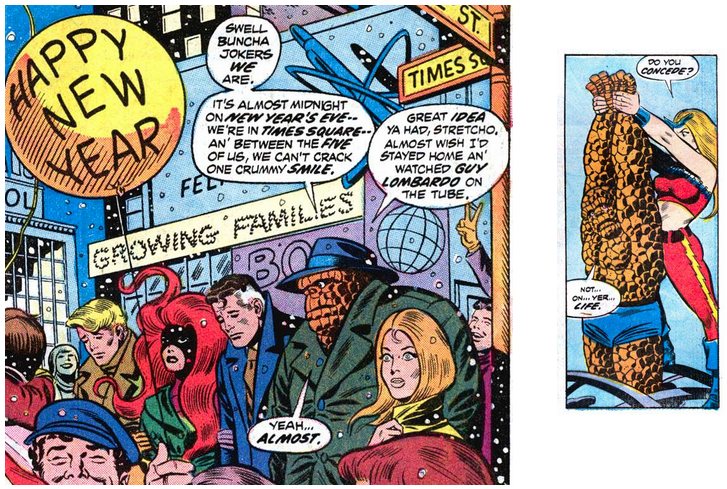
Now it's Ben's turn:
- Reed and Sue have separated.
- Johnny has lost his soul mate to another man.
- Ben has long term depression, but at least he still has his
strength. That is about to take a major kicking, as Ben is being
beaten by a woman in front of thousands of people. From now on,
people will assume that Ben has nowhere near Hulk class
strength.
- As for his relationship, that is a source of his own pain. He
can never move forward due to his inner fears.
Ben's head injury
Thundra's win was not due to superior strength. Before the
battle Ben was suffering from a head injury. Thundra did not know this.
But she specializes in taking down super-powered males by an attack to
the neck. Click for details.
The moral message: Ben is beautiful
In this issue Ben falls, but in dramatic contrast we
see that he is beautiful. This is a great moral message: nobody is ever
ugly, we just need to see ourselves in a different way. Here the
greatest alpha female of them all, the most beautiful and most powerful,
both physically and politically. She could have any man she wants, and
she recognized Ben's true beauty.
Thundra and Ben's inner life
The appearance of Thundra highlights Ben's relationship
with Alicia: Thundra is a woman who acts to get what she wants,
and she wants Ben (over the next few issues it becomes clear that
she admires him). Whereas Alicia is passive, Thundra takes what
she wants, and she wants Ben. Here then, is all the proof Ben
needs that he is not ugly: two women want him, besides his legions
of more distant fans. Yet he cannot commit to either of them. He
can't move forward because he believes he is ugly.
Ben's rocky exterior is a symbol of his emotional state: He is a
brick wall. He does not move, because of his depression, and he
does not let others (such as Alicia's gentle love or Thundra's
more active approach) move him. Eventually, in three more years
(their time), Alicia will have to take matters into her own hands
and make the drastic choice that will finally kick him out of his
stupor. Ultimately Ben is not defeated by Thundra, he will be
beaten by blind Alicia. As a fighter he will take the beating,
reassess, get back up, come back and win. The final reconciliation
of the Ben - Alicia- Sharon situation is not recorded due to the
series abruptly ending after FF321, but
it's implied by what we know of what
happens next.
A snapshot of the long term story
This issue starts with a snapshot of how far the team has fallen. If
you want proof that this is a 28 year story and not just a comic,
here is the picture. It takes place in a real place on a real date
(Times Square, New Year 1973). The team's problems can be traced
back to FF60, in 1966. That's when it first became clear that maybe
Reed was not the best one to lead the team. It was also when
Johnny's immaturity became apparent. Since then things have only got
worse. The causes can be traced even further back. Reed's
personality is probably from to either childhood autism or his
usually absent and self centered father. Johnny does not know what a
man is supposed to do because he never really knew his father and
only has Reed as an example. It will take years for them to finally
overcome their problems, but overcome them they will.
This wrestling symbolizes the internal struggle in both Thundra and
Ben's life. Both go on to be professional wrestlers in Ben's own book:
Thundra in Marvel Two in One, and Ben in The Thing.
Gerry Conway, aged 20, and the
Zeitgeist
This was Gerry Conway's first issue as writer. He was only the
fourth person credited as writer. This is Marvel Comics' flagship
title and he was barely twenty years old. (FF133 is cover dated
March 1973, but as the story implies it was on sale in early
January, so it would have been written around September 1972 or
earlier. Conway was born September 1952. When he was just 14 he had
a letter printed in the climax to the Galactus saga, FF50. Two years
later he began writing comics professionally.)
"I think people often forgot how
young I was, and expected me to perform at a level that was
actually beyond me. The result was, I was pretty stressed for most
of my early career as a writer, and I often felt like I had no
idea what I was doing —which was true. I wrote instinctively and
from the gut; when those instincts were appropriate to the
material I was writing — for example, when I was writing [The
Amazing] Spider-Man — the results were something I was quite proud
of, then and now. When my instincts were off, I didn't have the
experience to either recognize it, or to compensate for it, with
results that were more uneven." (from an interview on
Fantasticfourheadquarters.com in 2009)
Conway was a young man writing from instinct. His stories about men
versus women, featuring two glamorous and powerful women on the
team, channeled the spirit of the times.
Ramona Fradon and female empowerment
This is the first of the issues where women rule, and outsiders
(Medusa, Thundra and Tigra) play an increasing role. So it is more than
coincidence that this is the Ramona Fradon issue: the first female
penciler of the Fantastic Four. Her first page is arguably the most
important image of the 1970s, showing the passing of time and its toll
on the family as individuals. FF1by1 explains:
"The first that should be said about this issue is that it features
the remarkable work of Ramona Fradon. A mainstay at early DC (she had a
respected run on Aquaman and helped create Elemento) she only produced
one printed work at Marvel Comics… and this is it! It’s a real shame
since, although at first glance her art may seem overly-stylized, her
work carries an expert flow and an exceptional use of composition and
focal points. Reportedly, she could not get on with the very loose
Marvel style of writing (at that time), and this shows in the pacing of
the issue, which is a little uneven and carries very little finessing."
To be fair, there were unnamed female colorists before then, and
coloring has a huge impact on the power of a comic: but that is a tale
for another day.
"The zeitgeist:The Battle of the Century - Any Century!"
One of the great things about the FF is the hyperbole: because it
usually turns out to be true! Take this issue for example. Two issues of
the FF are called "The Battle of the Century": FF26, and this one.
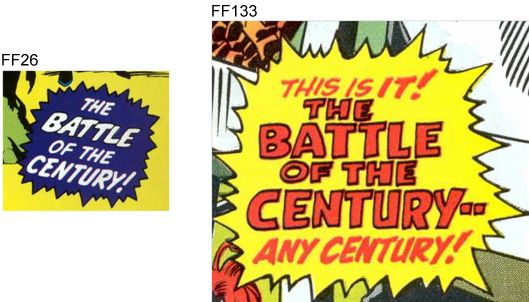
There is no contradiction, and both statements are accurate:
- FF26 is the battle of "the" century.
Many fans consider the Thing Versus Hulk fight to be the battle of the
century: and if we accept the thesis that the Fantastic Four is the
Great American Novel then it's hard to argue that other battles beat it.
(1976s Superman versus Spider-Man one-shot probably comes close, due to
its historical significance, but it falls short for several reasons.
The story had no impact on continuity, no character development, is
short contrived, one sided and lacks any tension or significance other
than as a gimmick.)
- FF133 us the battle of "any" century.
This symbolizes the battle of the sexes, which has historical
significance far beyond almost any other trend in the twentieth century.
For all human history and probably for long before, in almost all
cultures, women were treated as inferior to men. Yet suddenly in culture
after culture, throughout the world in the twentieth century, women
began to be treated more equally. There is still a long way to go, but
the change is dramatic. Noah Harari, in his book ""Sapiens: A Brief
History of Humankind" devotes chapter nine to the topic. He offers
several possible explanations but finds none of them convincing: why
were women always and everywhere treated as inferior, and why did it
begin to change in the twentieth century?
"At the beginning of the twentieth
century the idea of giving voting rights to women was generally seen in
the USA as outrageous; the prospect of a female cabinet secretary or
Supreme Court justice was simply ridiculous; whereas homosexuality was
such a taboo subject that it could not even be openly discussed. At the
beginning of the twenty-first century women’s voting rights are taken
for granted; female cabinet secretaries are hardly a cause for comment;
and in 2013 five US Supreme Court justices, three of them women, decided
in favor of legalizing same-sex marriages (overruling the objections of
four male justices)." (Part of the conclusion to "Sapiens" chapter 9)
As the cover to the FF states, "this is the battle of the century-- any century!"
"The Battle of the Sexes"
FF133 is cover dated April 1973, so was on sale around January and
written around October 1972. The term "battle of the sexes"
referring to a high profile sports battle between a man and woman came
six months later, when Bobby Riggs played tennis against Margaret Court
on May 13, 1973. The location? Ramona, California. A pretty good
coincidence, as a Ramona draw this issue. Riggs won the match, leading
to a much bigger and more famous rematch, against Billie Jean King on
September 20, 1973. King won.

Other points to note:
-
The first Marvel Comic!
This is the first issue officially published by Marvel Comics group,
according to the indicia, the small print at the bottom of the splash
page. Until then "marvel comics group" merely referred to how Martin
Goodman grouped magazines for selling advertising space. The publishers
did not call themselves Marvel until FF133.
At first (until FF 81) the book was attributed to "Canam
Publishers", a fake name to avoid
creditors. Then briefly "Perfect Film and Chemical" (until FF 83): this was the new parent
company after the 1968 buyout. Then
we have "Magazine Management", the real magazine publishing company run by
Martin Goodman, the real publisher. Thanks to Billy's "Comics Should be
Fun" blog for pointing out the small print! Incidentally, I don't have a
copy of the indicia to issue 1 - the official DVD replaced that page
with the equivalent page from issue 8. I don't know why. But issues 2 to
81 say "Canam publishing" so I presume that issue 1 was the same.
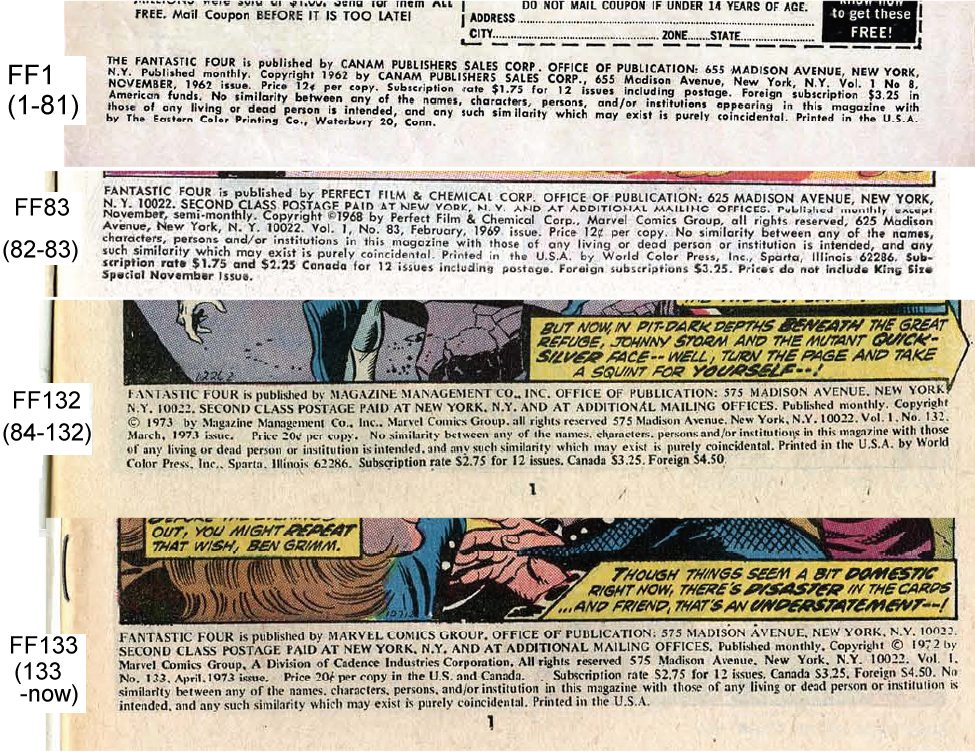
Using the name "Marvel" across the board reflected a new confidence, after the uncertainty of the early 1970s. Sales had been falling since the decisions of 1968,
and many in the industry thought superheroes wee a passing fad. But the
distribution trick in issue 116 gave sales a boost, and now, two years
later, the
publishers had confidence that superheroes were here to stay. (The
trick was raising the cover price and page count, getting DC to copy,
then dropping the page count and price again while DC remained
expensive).
134
Issue 134: The love issue: and Reed quits something for the first time
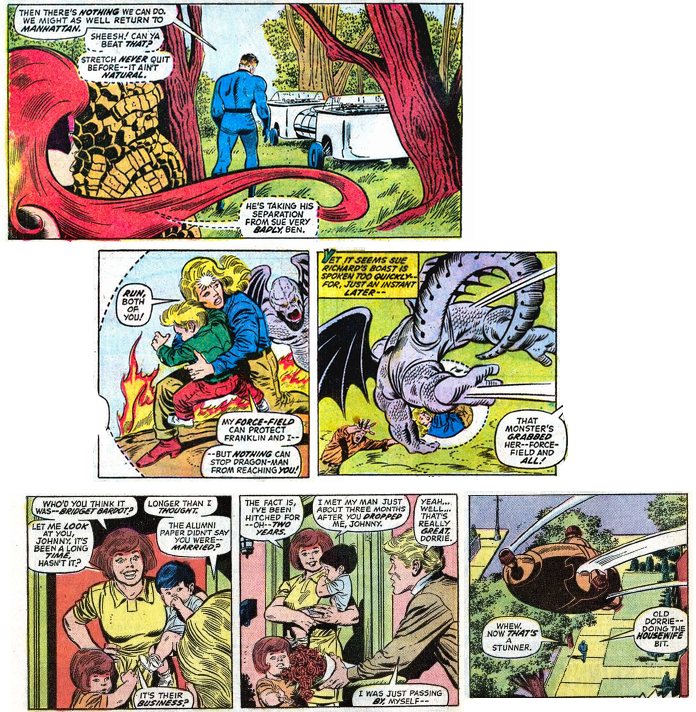
The events of this issue symbolize the problem of the whole year:
Sue's house disappears from under her, and Reed, unable to function
alone, is too depressed to react.
The love issue
This issue shows the team's deep emotions by contrasting them with different kinds of love:
- The tragic love of Reed and Sue: the last page to this arc (next issue) is so painful.
- Conventional domestic bliss: Dorrie and her new man and her children
- Boyfriend/girlfriend: Johnny's aching heart from losing his true
love, and wanting to reunite with an old flame. Note that Johny first
had a crush on Medusa (see FF 43) and now she is on the team.
- Sue and Franklin: A mother will do anything to protect her child
- Gideon: a father's belief that he does everything for his son, but he really just loves his work
- Normal friendship (Carol, Sue's friend)
- An animal's love: Dragon man is forced to obey Gideon, but really loves Sue
- Love of power (Gideon)
- Duty: Medusa's role in the team. They are friends and fellow
heroes, so she abandons her home to be with them for as long as it
takes.
And in the second part of this story:
- Alicia's pure love for Ben
- Common humanity: (in next issue's flashback) the ordinary fishermen who rescued Gideon
- Love of celebrity: the team's faces sell magazines, they were once "people of the year" on Time
- etc.
Love and autism
I have argued elsewhere that Reed must be autistic.
This issue gives another sign: he hates giving up on anything (for an
autistic mind, things have to be complete). So many of the signs. I know
that I make Reed sound like a villain in this web site, but it's only
because it's so obvious he is a hero in every sense: he has a desperate
need for things to be right (a strong autistic trait). He has the purest
heart and works tirelessly to only do what is right. That should never
be in question. So that makes the other side of autism all the more
poignant: while he finds academic subjects easy, he finds emotional
matters very difficult. So in this, the climax to the building emotion
of the past years, he finally cannot cope. He walks around stiffly, as
if completely unconnected, he barely reacts, and for the first time in
his life he gives up. At the end (thanks to Gideon) ends up flat on his
back. Reed has finally faced the one thing he cannot defeat: emotion.
I am diagnosed autistic myself, and totally relate to Reed. (Reed is
my avatar on the FF comic boards.) I can feel the unbearable stress he
must be going through. Such a powerful issue.
"Reed never quit before: it ain't natural."
This issue is about Reed's depression. Time has moved on (as we
see from Dorrie), and Reed's hopes and dreams lie in tatters. He has
lost his golden touch, and lost the respect of those who matter most.
This issue has been
criticized because Reed does not react to the destruction of the house.
But that is the whole point: he is so depressed that he can barely
respond to the world around him. He is self absorbed, unable to react.
He will have three opportunities
to turn back from the brink, but will miss them all, resulting in
catastrophe in FF241.
Reed's two stages of depression
Note that Reed has two "rock bottom" periods: this, and the very end of Act 4. But there is a progression.
- Inability to act
Here, Reed is simply depressed: unable to even react to events around
him. Even the disappearance of the house containing his wife (as far as
he knows) cannot evoke a response. This is perhaps the defining feature
of depression - the depressed person can barely feel anything other than
the darkness.
- Self destruction
By the end of Act 4, Reed has moved beyond this. His enormous intellect
moved from inability to react, to a mechanical focus on self
destruction. The final period is when Reed mechanically goes through the
motions, where his words become cold, he loses all passion. While his
face bends into whatever smile shape is needed, and he silently plans
suicide (see the notes to Byrne's run from FF232, and FF 251 in
particular).
On dragons
Note the symbolism of the dragon grabbing Sue and Franklin. In
western mythology, dragons represent sin, and are killed by heroes to
demonstrate the hero's power. Here Reed's errors have caused him to lose
his power to act as a hero, so a dragon takes his family and there is
nothing he can do about it. In eastern mythology dragons represent
wisdom, and here Reed is no longer the wise one. Reed's weakness is his
refusal to put Sue first. Dragon man loves Sue in a simple, childlike
way, so he puts her first. The great irony is that the simple-minded
dragon is wiser than the brilliant hero.
Years have passed
In the previous issue we saw time passing That theme is emphasized
here. This is also the first issue where we really see that
serious time has passed:
- Dorrie Evans was Johnny's long time girlfriend at high school.
She is now married with kids. Like Johnny she must be about 24
years old now. She met her man three months after she dumped
Johnny: that is, in early 1966. She then got married in 1969 and
had her first child around the same time. it is now 1973 real
time, but will feel like 1971 due to time stretching.
- Franklin looks like a small child and no longer a baby.
- We see Sue as a mother, with a life beyond Reed.
We also see clues to the future:
- This issue is about how Gideon's life must put his son first,
just as Reed must. It foreshadows the time when Reed will
finally focus on his family.
- We see the kind of life that Sue enjoys, given the choice.
- Gideon's underground lab probably reflects Reed's new lab in the next generation: If
Sue has her desired normal home she won't want a skyscraper
attached. Reed will have to build downwards.
The 100 issue cycles
Throughout the FF we see 100 issue cycles. This is perhaps the most obvious example:
- Gideon from FF34 returns in FF134.
- The two issue arc includes 135, exactly 100 issues after Dragon Man appeared.
- In 234 we see other parallels to this issue: vast power goes
unnoticed (Franklin and Skip), Skip's abilities wasted by depression
(like Reed's, and by extension Franklin's), the destruction of buildings
for unknown reasons (like the house in 134), the degenerative diseases
from nuclear tests (like Gideon's disease), the unknown causes, the
father misunderstanding the son (Skip versus his son), the monstrous
egos of Gideon and Reed reflected in the doomed planet in 234, and so
on.
- For another prominent example of the 100 issue cycle, see the commentary to 69-72, 169-172 and 269-72.
The suit and Reed
The 100 issue cycle is just part of the bigger structure. Here Gideon
wears a life support suit that separates him from physical contact with
loved ones, and Reed will do the same after his final negative zone
experience.
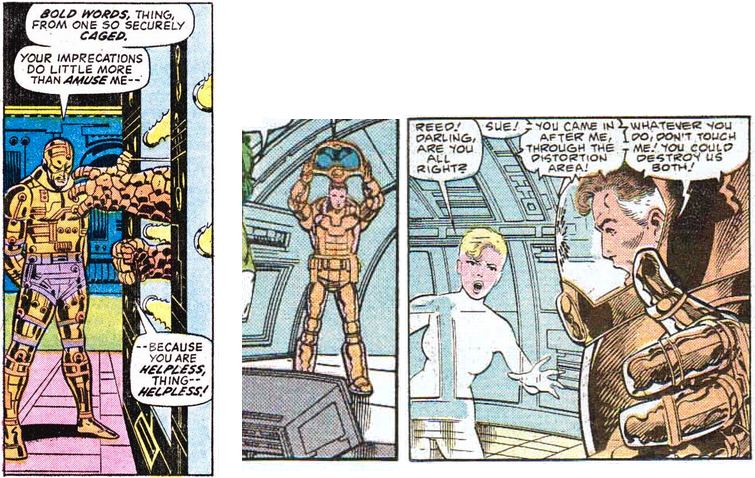
In the final stages of Act 4, Reed will be faced with every symbol of
the enemies who reflect his weakness. The final element to push Reed to
self realization will reflect his greatest foe's greatest hubris: in the
final issue of Act 4 Reed will see a city that exists to honor him,
just as Latveria exists to honor Doom.
Criticisms
- Does Gideon's return undermine the original story?
No, it reinforces it and adds depth. Gideon was always a mirror for
Reed. Like Reed, he promised to put his family first:
- Gideon first
appeared in FF34, and promised to put his family first, just as Reed
promised to put Sue first in FF35. But the ego of both men proved too
strong.
- Gideon's moral
decline mirrors his recent illness, just as Reed's physical health has
declined over the past 12 months (since FF122).
- Gideon wants
to challenge the gods themselves (see the last panel) and is driven to
crazed frustration by his inability to do everything. Compare Reed in
FF122-3.
- His suit is a barrier to the outside world, made of high
technology, just as Reed surrounds himself with technology rather than
getting to know his family.
Other points to note:
- Reed and Agatha
Agatha's house is completely wiped off the Earth. Yet when it
returns Reed continues to send Franklin there, even though he
plainly is not safe. Reed must have serious issues with not
wanting the child.
- The art
While undoubtedly an enormous talent, John Buscema isn't normal my
favorite artist. But in this issue he hits it out of the park. Look at
that Dragon Man cover and first appearance! The cutaway! Buscema is on
record of not being a fan of superheores, and I think it shows, e.e.
when he draws Gideon in his suit, but when he touchees n fantasy and
soap opera images he is in his element.
- Franklin
We get the biggest clue yet of Franklin's power. Before we saw
that he was aware of the news even when in a different room. Now
we see that ants obey his desire: if he wants them to move in a
certain way then they do.
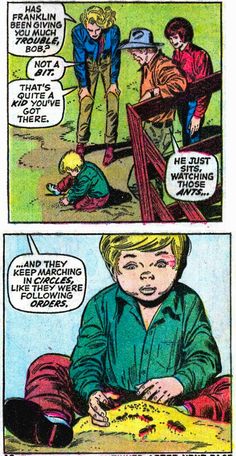
Does his control unconscious control only apply to insects?
Remember the first appearance of Galactus: from a higher
perspective we are all ants.
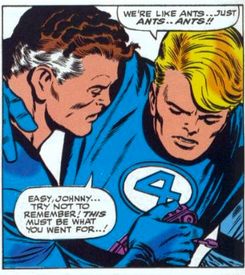
FF 135-142: three stories of mishandled power
The next three arcs feature three beings with reality warping powers:
the Shaper, the Miracle Man, and Franklin.* The first offers power
without understanding, the second has illusions, and the third has power
without awareness. These are three examples of power wrongly handled,
and climax in the disaster at the end of FF141.
In each case, the story ends with a loss of respect. The shaper cannot
respect Slugger Johnson, so Slugger loses his power. Ben cannot respect
the Miracle Man, so he loses his power. Ben cannot respect Annihilus, so
can really let loose. And ultimately none of them can respect Reed, and
so the team falls apart.
*(Why do three reality warpers appear together? The appearance of the
Shaper and Miracle Man may reflect the disruption in reality caused by
Annihilus' attack on Franklin.)
135
Issue 135: the Nuclear arms race
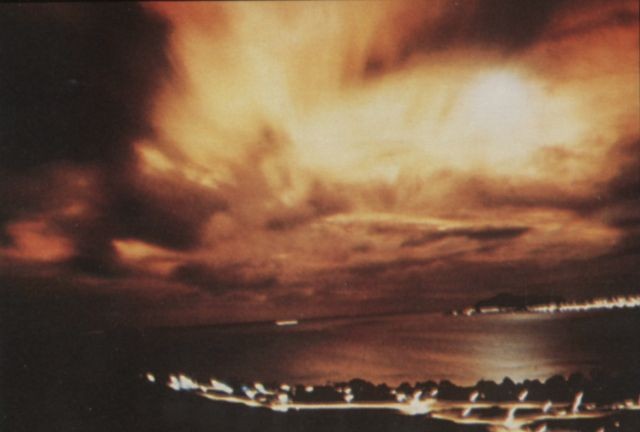
This picture is Starfish Prime, a high altitude nuclear weapons
test in 1962. Here is it seen from Honolulu, over 1400 km away. The
blast damaged equipment in Hawaii and New Zealand. As a result of tests like this, in
1963 all above ground weapons tests were banned. But nations still
tried to find ways round the ban, such as by exploding bombs only just
below the surface, and radiation would inevitably escape.
"The most noteworthy violation of
the Partial Nuclear Test Ban Treaty took place at the Chagan nuclear
test in the Soviet Union, carried out on January 15, 1965. The charge
was powerful enough that some fallout rained upon Japan, and both Japan
and the United States complained, but the complaints were eventually
dropped, and the problem was ignored by the foreign governments." (Wikipedia)
In late 1964 Gregory Gideon had tried to defeat the Fantastic Four
financially (FF 34). He changed his mind and vowed to focus on his son
instead. So they went on holiday, but on the way back
flew into the fallout from an unexpected bomb. This was most likely the
January 1965 test, and Gideon was flying over Japan.
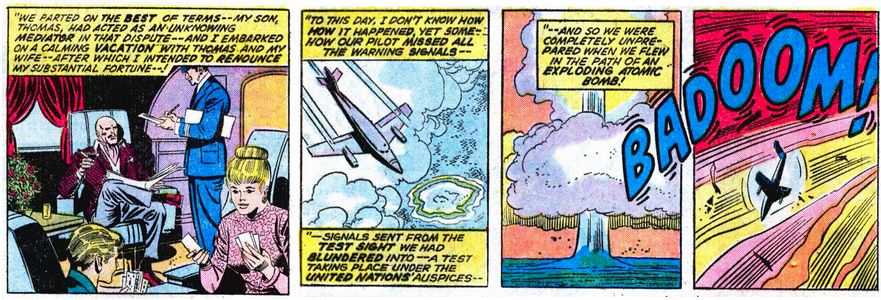
Gideon's reference to "United Nations' auspices" is probably a bitter
comment about how the UN was supposed to stop that kind of thing (How?) ,
and that charges were later dropped.
So Gideon's use of Dragon man can be seen as an unconscious nod to
Godzilla, another innocent yet deadly monster, symbol of Japan's
experience of atom bombs.
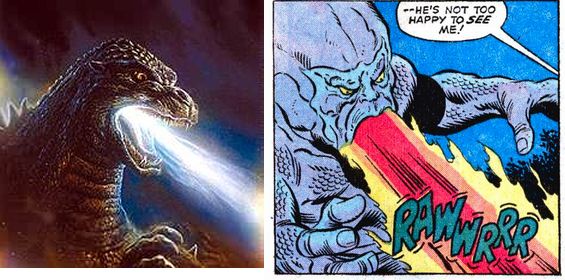
The good guy has to make a death machine
Gideon is an innocent victim here. but the only way he can see to
survive is by doing something terrible that hurts others. This
symbolizes the arms race: each side sees themselves as the good guys,
but they have to make death machines in order to survive. The name "the
eternity machine" reflects the awful finality of nuclear war.
The Zeitgeist
This issue was planned in late 1972, the start of SALT II (Strategic Arms Limitation Talks). As usual the
Fantastic Four reflects the mood of the times.
For later developments in the nuclear arms race see the notes to the end of John Byrne's run.
Sue and Reed: symbolism

Here Reed, representing America, is asleep while the nuclear arms
race continues. And Sue, representing those who just want peace, feels
he cannot be trusted with the next generation (Franklin)
Sue does not blame Reed. She doesn't know what to think. This
indicates that the problem is not as clear as the surface
argument: that Reed does not care for her, e.g. wanting her to
stay away, with Franklin (FF127). Certainly Reed does care for
her, hence he goes to pieces when she's away. Then what is the
real problem? That he can't show it? or something else? Sue has to get away. She can't handle this.
Show, don't tell
Sue tends to work by intuition, not logic. She may not be
consciously aware of what bothers her so much, but her body language
makes it plain. She is almost always wit Franklin, She could leave
him with her friends but does not. She likes to be close to
Franklin, and Reed does not. That's the crux of the matter.
It may be hard for Sue to process exactly what the problem is,
because on the surface it seems like Reed also cares for Franklin.
After all, didn't he want to make Sue stay with Franklin in FF127?
But he never says "one of us
should be with Franklin" it's always "you should be with Franklin." The real issue is
not that Reed does not want to be close to his family. That is what
Sue cannot accept.
Ben's neglect: the irony
Reed is only the most visible tragedy here. Ben is guilty of the same
neglect. In FF134 Ben complained that Reed just plays with his test
tubes instead of going after Sue. But what is Ben doing? Sitting around
reading comics. In this issue we see that Alicia has a chance to restore
her sight, and Ben hasn't been around often enough to even notice!
Both Ben and Reed neglect their lovers, because both feel powerless.
With both men their self image does not fit reality: Reed thinks he is
the natural leader, but all the evidence says the opposite: yes, he's a
great hero and the world's greatest scientist, but he lacks people
skills. Meanwhile Ben thinks he cannot be loved, whereas all the
evidence says the opposite - everyone loves Ben, and the most alpha of
alpha females, Thundra and Tigra, find him especially hot. Nether man
can see themselves as others see them. Both are trapped by their false self image.
Other points to note
- Unconsciousness: symbolism
Reed is comatose for the entire issue, symbolic of his mental
helplessness. Last issue his depression made him barely able to react to
events, and this issue he is physically unable, allowing us to focus on
those around him instead.
- Superscience
Note page 12: the ease of controlling Dragon Man, an unstable
molecule based life form. Compare a similar control in FF35,
exactly 100 issues earlier. For details see super technology.
- Their public reputation
Time magazine showed the FF as "people of the year" and it was
"eight months ago." If the magazine was recent it almost
certainly refers to FF123, the only time in the previous couple
of years wen the FF was popular. The "people of the year"
article is typically published toward the end of the year,
suggesting perhaps a six or seven month gap between FF133 (New
Year) and FF134. However, FF140 indicates that Sue was only in
Pennsylvania for "several weeks" so it must have just been an
older magazine.
136
Issue 136: the foundations of marriage

How this fits into the bigger story: the sanctity of marriage?
This issue continues to explore the near divorce. The normalization of
divorce was a hot topic in the 1970s, in contrast to the 1950s when
divorce as still strongly frowned on. (In between was the 1960s, a
period of transition). This reminds us of Reed's patriarchal style,
where the man of the house is the natural leader and his wife is
expected to obey. So the question posed in this issue is, were the 1950s
better?
Part of the reason that Reed treats Sue as dependent is the age gap.
He was born in around 1926, she in 1941 (at least, that is the image she portrays). That's a 15 year age gap.
They met when she was 12 (see FF291) and he was 27. No wonder he
always thinks of her as a child! Reed became an adult in the 1950s.
For Sue it was the 1960s. This issue is about the 1950s attitudes
versus 1960s. it represents Reed versus Sue.
The personal story: ignoring others
The success of marriage depends on the individuals. This issue is about seeing a person as an individual with their
own value. Reed loves Sue, yet he cannot accept that she has her own choices.
He says he expects her to be there in the morning, and he cannot
believe she would have gone away if Dragon man was there. He still
sees her as dependent on him. This will not change until Namor steps
in, in FF247.
FF132 was about slavery, and groups we ignore. This is issue raises
the question again, by focusing on a henchman. Normally in comics
the henchmen are disposable and the villain comes back, but the FF
is about realism: we stay behind to see what happens next. We are made
to see the henchman as an individual, with ideas, opinions, a family
life and a childhood. This is just as revolutionary as any of the
changes in the early years of the book.
The Great American Novel
- The American Bicentennial is approaching,a nd this is one of a
number of issues that explored American history:
- Giant Size FF 2 has the colonial period and 1920s
- FF annual 11 has World War II
- These issues have the 1950-s and 1960s
- And of course the contemporary issues themselves reflect the
1970s, which Ben sums up nest issue as "riots, pollution and
women's lib"
- The themes are pretty obvious so don't really need discussing
here, but some points may not be obvious to younger readers (he
said, condescendingly): "This
story may have been inspired by the 1950s nostalgia going
around at the time, such as the "Grease" Broadway show and
"American Graffiti". The title to #136 refers to the 1950s
Bill Haley & The Comets song 'Rock Around The Clock'."
(source)
Other points to note
- The shaper of worlds is a symbol that we shape our own world. he
appears now at a critical time: whether Reed and Sue divorce or not
will shape their future. He plays a similar role to the Watcher, except
the Watcher appears at times that seem inevitable (such as the break up
of the FF in 189). The Shaper is here because nothing is inevitable: the
FF must decide what they want.
- As usual the 100 issue cycle has patterns and parallels.
FF136 is 100 issues before FF236, the triple sized celebration issue
that again focuses on marriage and shaping a world. FF136 is half way to
272, which has the elements of marriage and shaping of worlds (Reed
finally meets his father and his father's new wide on their own world).
It is 101 issues after FF35 where Reed and Sue got engaged, and 100
issues after FF 36, where once again Reed is asleep, and once again
Medusa featured, this time as an enemy.
- McCarthy is renamed McHammer: McCarthy is known for his witch
hunts, and the most famous book on witches is the Malleus Mallefactorum,
the "hammer of witches". Amusingly given the context of racial tension
and music, by the 1980s black music was completely mainstream and one of
the best known acts was called M C Hammer.
- Gideon's son tried to talk to Reed, but Reed brushes him off with
"later, son" and promises to study his problem. But he never does: in
every way this parallels Reed's relationship with Franklin.
137
Issue 137: the 1950s: the old white guys no longer have the answers
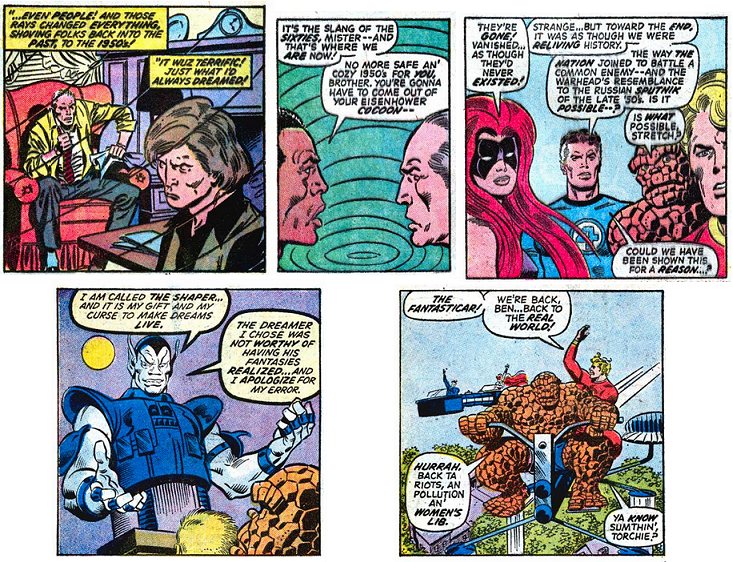
In this issue a henchman gains Einstein like intelligence, but finds
that he still cannot solve the human problems. This reflects Reed:
give him a physics problem and he's in his element, but give him a
human conflict and he struggles. This also reflects the real
Einstein: he spent much of his older years regretting and
campaigning against the nuclear weapons he had promoted as a younger
man.
Social commentary
This issue is about our dreams of power. It concludes that people who
just want conflict and to rule do not deserve power. Instead power is
given to the son who saw his father reject wealth and wants to put
family first instead. It shows that most dreams are illusions: Movies
and fear of sputnik are not real dangers; the older or younger
generation are not the real enemy. The real enemy is the lust for power.
The most powerful being there, the shaper of worlds, is the one who
gives power away.
Just a pastiche?
Some of the ideas in this issue may appear cliche, but it's the real
deal: the writer, Roy Thomas, was born in 1940 and grew to adulthood in
the 1950s: an English school teacher at first, with a love of history,
he paid attention to the world around him. Letters to the editor suggest
this story was particularly well received.
The Great American Novel
The Great American novel covers the entire period since America became
the most powerful nation (after World War I). Most of it is a real time
commentary on the height of the cold war (1961-1989), but it also has
one story from each of the other decades:
- The 1920s: FF91-92
- The 1930s: FF291-292
- The 1940s: FF annual 11
- The 1950s: FF 136-137
- The 1960s, 1970s, 1980s: (real time publishing)
Reed's last warning
At the end of this issue Reed wonders if the message was for them.
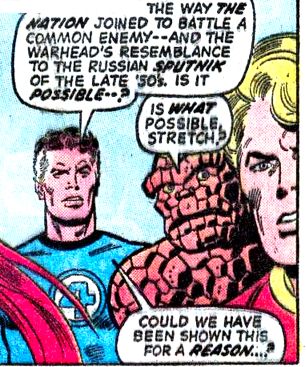
Obviously he sees beyond the superficial "blacks and whites should
be friends." message. The Shaper was attracted to Slugger by mistake,
because he was irradiated by Gideon's machine. The machine is what
mattered: it was designed to drain the genetic material from Reed, Sue
and Franklin. In two years and a thousand experiments Gideon had
discovered what Reed had failed to even try to find out: the power of
the family's genes. This machine attracted the Shaper of Worlds.
The Shaper focused on specific aspects of Slugger's dreams: youth, and
the contrast between old and new ideas. These things reflect Reed (old
fashioned), Sue (more in tune with the seventies and women's liberation)
and Franklin (the child with infinite potential and dream power like
that of the Shaper).
What Reed missed
Had he investigated further, Reed could have seen why the Shaper was
attracted, what the dream world meant, and the parallels between Thomas
and Franklin: in particular the absolute need to to put his son first.
If Reed recognizes the parallel he will rush to Franklin's side and make
him the top priority before Annihilus arrives and it is too late. Reed
almost does this: next issue he stays behind to experiment. But he does
not focus on his son, and instead something about his antimatter
experiment affects the Negative Zone portal and lets Annihilus in.
The tragedy
This is a Shakespearian tragedy: like Caesar, Reed missed the warnings
that could have saved him. Twice he walked away from a scientifically
fascinating scene: from the missing house and from Gideon's technology.
The old Reed would have studied the evidence and (a) found Sue, then (b)
understood Franklin's DNA. But instead, depressed, he just left, and
the opportunities slipped through his fingers.
In short, the Shaper was Reed's last chance and he blew it.
Criticisms (source)
This issue was popular at the time because many readers recognized the
rich symbolism. Modern readers recognize less of the symbolism so tend
to see only the most obvious messages: e.g. against racism - and so do
they miss the pleasure.
- "Why is Slugger Johnson living
as The Brain, an existence in a medieval setting when he it’s apparently
the ’50s that he longs for so much? "
As explained in the text, horror and monster movies were a big part of
the 1950s. Slugger lacks creativity, and cannot face reality, so his
ideas come either from his simplistic teenage years or from movies.
- "Why is it others who have their wishes of power fulfilled and he is a frail old man?"
He is not frail: as explained in the text he becomes Einstein. This is
his power fantasy: he wants the power that comes from being smart and
having the world look up to you. When this fails he takes on the role of
the warhead, smashing everything.
- Why is The Shaper apparently part robot?
We are not told, but the giant motorized assistance appears to represent
his limitations: he does not have the full range of human
characteristics; he needs assistance.
- What is the point of having the FF storm a castle only for it to turn into a drive-in movie theater?
- As explained in the text, Slugger was not able to make use of his brain, so he chose a more violent alternative.
- Why do the guards turn into bikers who stop fighting against the
Fantastic Four and instead aid them in defeating the plans of Slugger
“The Brain” Johnson?
Because Slugger ended up frustrated and decided to kill everyone: so he
became the primary threat. This represents how the perceived Soviet
threat united America.
- "Characters constantly reveal information that they were never told"
I see no examples of this."
- "The brain conditioning that they underwent just wears off arbitrarily."
No, this is implied in the text: this world reflects Slugger's desires.
As Warhead he is stunned, so immediately his control weakens.
- "And again, the FF are
apparently completely fine with a being with nearly godlike powers
whisking off a frail young boy to live within his dreamworld."
The being is saving his life: to prevent it would mean the boy dies.
The being promised to bring the boy back, and he has shown he always
does as he promises.
- "It
shows a young man rousing an army of people with his own skin color,
yet neither he nor any one of them is given an actual name by the
writers. [...] It’s a very low bid for interracial sensitivity."
The man was named Marty: see page 27. This is not intended as a blow for
racial sensitivity, but as a symbol of what happened in the 1950. The
whole point, stated both in this issue and the last, as that the black
man was effectively invisible, yet he was the only one to speak sense.
- Is Reed's comment "were we shown this for a reason" stating the obvious?
No: the obvious target was Slugger, not the FF. Reed can see there must
be more to the story than the Shaper accidentally getting the wrong man.
Who was the Shaper really looking for? What else was he showing? The
shaper can only respond, not create new ideas, so they have to guess.
Other points to note
- Most of the historical references should be obvious, but I
missed this one: 'The 'invisible man' description of
the black guy is a nod to Ralph Ellison's novel 'Invisible
Man'." (source)
- The opening castle image is beautiful. The penciler, John
Buscema, makes no secret of the fact that he prefers sword and
sorcery to superheroes. Meanwhile, the inker, Joe Sinnott, is
famous for always doing a professional job even when he loses
money on the work (because he could have finished two pages in
the same time). The result is this mini-masterpiece:
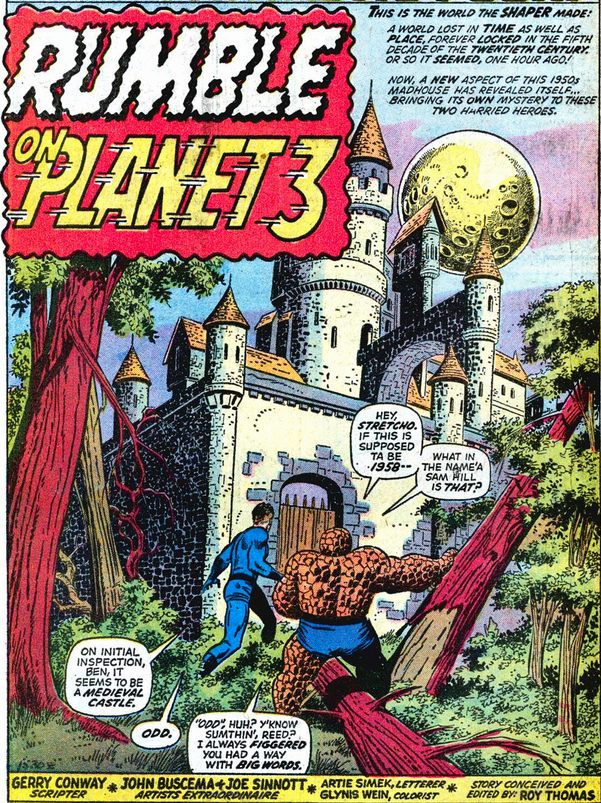
- In the previous issue Thomas was like Franklin. Here the theme continues: his dreams will be allowed to shape worlds.
- The cover is another homage to FF issue 1: note the positions of the
cast, the street scene and the rubble. Why 1958? The story is set in
1958, just three years before FF1 and the year when NASA was established
and launched its first satellite, as a response to Russia's Sputnik of
the year before.
- Slugger foreshadows Reed. Slugger zapped his own people because he was not able to
use the brain he was given: later Reed resorts to zapping his own son
because he did not use his own brain where it mattered, with his family.
138
Issue 138: philosophy 101
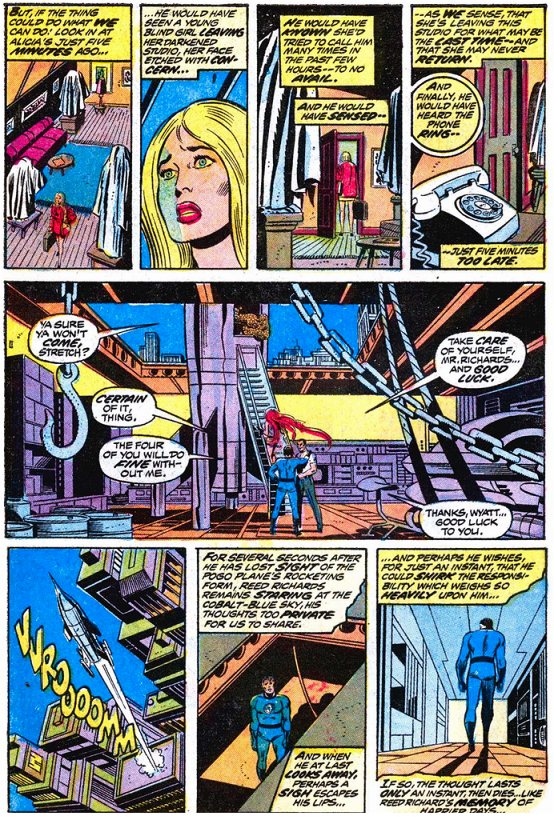
In these few issues our lonely Reed has been being forced to
think about big topics, not just the physics he's comfortable
with. This issue features another world shaper. This time it's not
about history and politics but religion and philosophy
The message: we must admit we
can be wrong
Why does the Miracle Man appear right now?
The Miracle man story (FF3) was about power coming from self confidence,
and that power disappearing when confidence disappears. That is the
situation Reed finds himself in now. The Miracle Man gradually regained
his confidence by going back to traditional values: will Reed? He will
need a miracle.
Building on previous stories
Two previous stories dealt with self delusion: FF3 (the Miracle
Man: they believed they were weak and so they are), and FF80
(Tomazooma: they treated a robot as if it was a god). This issue
combines
them: the Miracle Man in the role of Tomazooma, the god-like
being. This drives home the message of humility: that people can
be wrong.
Who has the stronger mind?
This story shows
the weakness of Reed by contrasting him with
Wyatt Wingfoot. The opening image shows Wyatt towering over the
team.
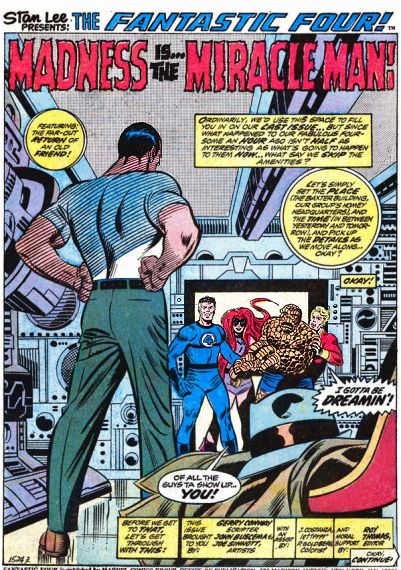
The Miracle Man story is a test of the mind. At this point Reed's mind is
weak. He even has trouble concentrating on experiments. The FF has super powers yet is weak. Wyatt has no super powers yet
is strong.
- Johnny dropped out of school, Wyatt did not: he is humble.
- Wyatt is sensitive to his people's needs before he is told,
Reed is not.
- Reed knows the family is in trouble, but expects his wife to
go to him. However, Wyatt goes to his family.
The team is weak because the family is divided. Wyatt is strong
because his family is strong.
"Pride goeth before a fall"
In this story the Miracle Man uses the same trick as before, a
form of hypnotism, and the team think they are too clever to fall
for it. Like Reed, their pride is their downfall. They literally
fall at the end of the story, down a huge pit (or so they think).
We have numerous clues that the new power is an illusion:
- Occam's razor: why assume great new powers when the simple old
ones explain it?
- Something is clouding their minds, as witnessed by how they
remember FF3 differently (this time they "remember" that the
theater performance used monsters; they were not impressed by
the feats; a monster is far from the city, Johnny used a "nova"
flash, etc.)
- The Miracle Man's story ranges from "too convenient" (he lost
his fake power and gained a real one. Really?) to implausible
(the silent ones knew nothing of the white man? These wise old
men were easily fooled?)
- Even Ben and Johnny say they doubt it is true, yet accept it
anyway
- When the next issue begins: they seem to fall forever, and can
talk while falling. Rather like the start of Alice In
Wonderland.
- The ending (in FF139) is too convenient for the Miracle Man.
When he sees he is defeated he is able to leave and save face.
This is just what an illusionist would do: a final illusion to
let him escape.
To defeat him, the Torch just needed a blinding light, like last
time, he does that in FF139, and it works. But first they have a
needless battle because their pride refuses to admit they are being
fooled again. They would rather believe the powers are real. They
need to realize that yes, they can be fooled again. They are not
immune to being wrong. They need humility, just like Reed.
The logical fallacy: argumentum ad lapidem
Ben tests whether the monster is real by hitting it. This is a
famous logical fallacy called "argumentum ad lapidem" or "argument
from the stone." The idea is that you prove the world is real by
kicking a stone: it feels sold therefore the world is real. But it
is a logical fallacy, because you could be just imagining that it
is real: it is only a proof against the weakest forms of illusion.
In this story Ben and Johnny are like Reed: they think the real
problem is outside of themselves. Reed thinks that Sue should make
the
first move: that she should come running to him. He does not
realize that, as with the Miracle Man, the real issue lies inside.
The inner belief must be addressed, and Reed and Ben and Johnny
must all admit that they can be wrong. No matter how much they
think they are right.
The power of the subconscious:
This time around the team think that the Miracle Man has real powers.
Obviously they thought that the first time as well. Consciously
disbelieving makes no difference: the Miracle man's power is over their
subconscious minds, which is why they can be physically exhausted while
fighting (and presumably even die if they lose). Their conscious minds
say "this is not real" but their unconscious brain belies it is real,
and their bodies react accordingly. Note the parallels with Reed's
depression: consciously he tells himself he must carry on as normal, but
unconsciously he cannot. In FF170 (169?) we see a similar
principle with Ben: consciously he tries desperately to change, but his
unconscious will not allow it.
Shakespeare again
This conflict between beliefs/intentions and reality is the bedrock of
all psychological fiction and is often seen in Shakespeare: things are
not always as they seem, and characters like Hamlet and Macbeth wrestle
with themselves.
"madness" in the title: a multi layered story
The Miracle man, like Reed, or like King Lear or Hamlet, must pass
through madness before finding new strength, but in the end even that
strength is an illusion: the one casting the illusion is himself
deceived. In the next issue it is revealed that the Indian elders were
always in charge, they just allowed the Miracle Man to believe he was
deceived. Note the parallels with the Celestials, who allow themselves
to appear defeated when it suit them (see FF annual 23, the backup
story). Also note the parallel Reed and Sue: Reed appears to be in
charge but it is really Sue who calls the shots.
Criticisms
- Motivation
FF1by1.com claims that "he also lacks motivation", but the need to feel
important is the biggest motivator of all. Just read "How to Win Friends
and Influence People", a top selling book at the time.
- The Miracle Man's power
Why didn't the Miracle Man regain his hypnotism after issue 3? Because he lost his confidence. Issue 3 was all about confidence.
Other points to note:
- Real time
Wyatt says he started college
four years ago. He did: he started in FF50, published in 1966,
and FF138, though published in 1973, is only four years later in
marvel Time. Also in this issue, Ben refers to his time in
WWII.
- Johnny and college
This issue confirms that Johnny dropped out of college. This
probably happened when he was chasing Crystal in 1967. Note the
1960s zeitgeist, to drop out and travel, now faces the 1970s
zeitgeist: the carefree hopes didn't work out as planned.
- The black costume
"No doubt he picked it himself because, balding and gawky, the black
seems self-consciously chosen to minimize any detailing of his own
awkward physique and his massive cape could have been chosen to help
further mask the same. Miracle Man obviously lacks confidence."
(FF1by1) . The blackness also represents the emptiness of his character: everything
about him is an illusion, including his own success. Contrast this with
the Indian gods, who are immaterial yet have more power than physical
beings. They appear to be deceived yet really understand it all. The
Miracle Man's madness is exemplified by is belief that he can defeat
immaterial beings by crushing them with rocks!
139
Issue 139: Reed admits failures
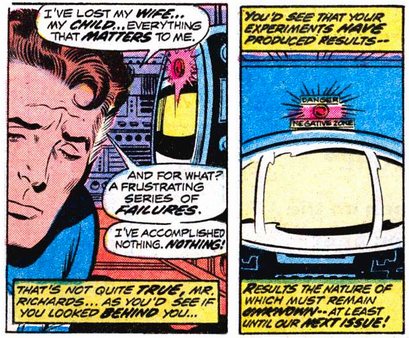
Reed finally accepts the truth. This truth is reflected in the main
story, where false beliefs based on vanity almost cause disaster.
The tide turns when they face reality: when Johnny tries his
blinding flash (implying that the Miracle Man is not much more
powerful than last time), and when Ben no longer believes the
Miracle Man is unbeatable.
Although Reed accepts he has failed in his noble efforts, he still
does not accept that he has ever hurt his friends emotionally, not
in any serious way. He feels defeated, but not humble. He feels
sorry for himself, but only because he was noble yet failed The rest
of act 4 is the long road to real humility, to acknowledge that he
is not better than other people. That realization will take some
time: Reed's suffering has barely started.
The moral: respect others
The key statement is at the end, Ben says that if you have to prove
how tough you are then you are not tough. The men who really change
the world are those who make the others around them feel stronger,
not weaker. Reed needs to be confident in his leadership so he can
listen to others without thinking the team will fall apart
R - e - s - p - e - c - t : Ben and Johnny break free
The climax of the story is when Ben defeats the illusion: he takes
charge. He realizes that the Miracle Man "has no class" and a that
moment Ben loses his respect for the man: the illusion is broken. This
foreshadows the next story, where Ben and Johnny, who have threatened to
leave Reed more than once, finally lose any respect for him and they
leave for real.
Land rights
FF1by1.com criticizes this issue for not discussing Indian land rights.
But as a committed Georgist (look it up!) I will point out that the
whole issue is about land rights. it begins with the Indians falling
down a hole in their land, literally trampled underfoot of the invading
white man with a black heart, who's claims are based on illusion and
greed - could the symbolism be more obvious? But rather than say "they
were here first, so it's theirs" the Fantastic Four goes deeper: it
addresses the philosophical basis of land rights.
What makes land belong
to person A or B? Simply occupying it? The the invader is the new
rightful owner. By occupying it for a long time? The the invades must use
all his power to maintain ownership until it becomes right by default.
The Miracle Man represents both claims, and clearly both are faulty.
The
only moral claim he has is that he creates something: his city is the
work of his own hands. Yet he does so by crushing and enslaving others,
which makes his city a mockery that laughs at him. At this point his
self confidence cracks, allowing the crushed people to rise from the
ground and take back control. The Miracle Man then drives the Indians
away, just as their grandfathers were driven to reservations. But
again they use the only moral claim they have to land: the work of their
own hands. Wyatt, representing the first nation people, builds the
raft.
Johnny could have whipped up his own whirlwind transport as he
did in issue 4 and again the previous issue, FF138. but it is important
to the symbolism that Wyatt is the one who's efforts create something
useful from than natural elements: as the philosophers agree, combining
his effort with the land is what gives him any claim to moral ownership.
Other criticisms
- The ending is deus ex machina?
No, the ending is realism. Obviously a far more wise and powerful group
would not be so easily tricked. The whole point of wisdom is to
anticipate possible outcomes. The point of the story is not that the
Miracle Man could trick them, but that he could not: he merely thought
he could, and they allowed him so that he could learn.
Other points to note:
- Parallels with the molecule man: he can apparently do
anything, but is taken away by a deus ex machina. He is a fake
molecule man.
- Parallels with Maximus and the Inhumans' city, complete with
alpha primitives. This is a reminder of the battle with Omega,
where the real battle was in their own minds.
- This is the Great American novel: one page is a homage to
Huckleberry Finn
- Authorial misdirection: we are encouraged to conclude that the
Molecule Man is affecting radioactive materials globally, but that is never actually stated. The Molecule Man's power
is an illusion. However, readers with long memories will recall
FF annual 6, the birth of Franklin: Franklin's power came from a
radioactive cylinder. At the end of this issue we see that great
danger comes from the negative zone, and we will soon see that
Franklin has the power to control everything. So the problem
with radioactivity is caused by Franklin, or possibly by
Annihilus' attempts to reach Franklin. The authorities' belief
that this would cause disaster in a matter of minutes is merely
speculation: they have no experience of this, so cannot really
know.
- This issue foreshadows FF151-156, with its the layers of
hypnotic illusion.
- Why is the Miracle Man harder to defeat this time? Because now
he believes his own hype, so he cannot easily be distracted.
140
Issue 140: Sue's growing self awareness
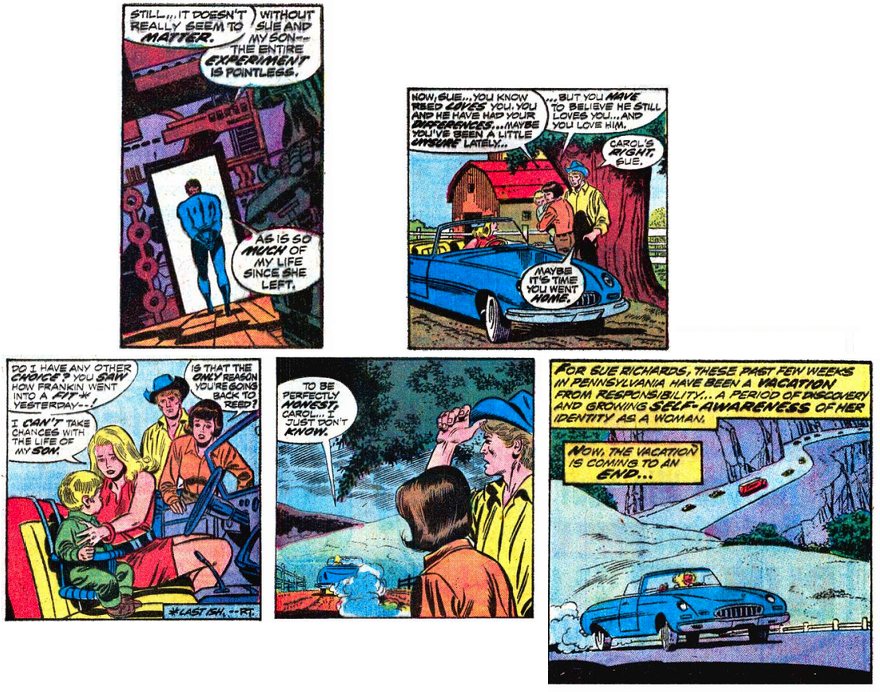
It's easy to forget that Sue has always lived in Reed's shadow.
She met him at the age of 12 (see FF291) and idolized him. He was
15 years older than her - more than twice here age! He was a
millionaire, a genius and a really nice guy. When her father went
to prison and she raised her younger brother she must have looked
up to Reed as an example of stability, a goal to aspire to. She
was only 20 when he took her in his rocket ship, and he was 35. No
wonder she found it so hard to question him! Coming to realize
that Reed has weaknesses must have been difficult.
Sue lived in Reed's shadow since age 12, was in his shadow in the
FF since the age of 20, and was married to him at the age of 24.
Now, at the age of 30, she is finally older than Reed was when
they first met. This is the first time she's been both physically
and emotionally away from him, the first time she could sit and
think things through. She loves him, but what does that mean?
Reed makes progress too
In this issue Reed admits that his wife and son are the most
important thing to him. This is a step forwards, but he still sees
himself as more important than them, otherwise he'd go and beg
their forgiveness and ask what he can do to make up, and then do it. Similarly, Sue does
love Reed but hat does that mean?
Other points to note
- Agatha asks Sue to come with her "of her own free will" - the
phrase used by Dracula when inviting people to enter his dark realm.
This gives evil forces power over a person. Crystal detects a similar meaning in DeVere's invitation in FF313.
- Gerry Conway recalls that FF140 and 1341 were the only issues he
scripted in advance: the rest were only plotted loosely, then dialog was
added after seeing the artist's work.
141
Issue 141: Franklin!!!!!!!!!!!!!!!!!!!!!!!!
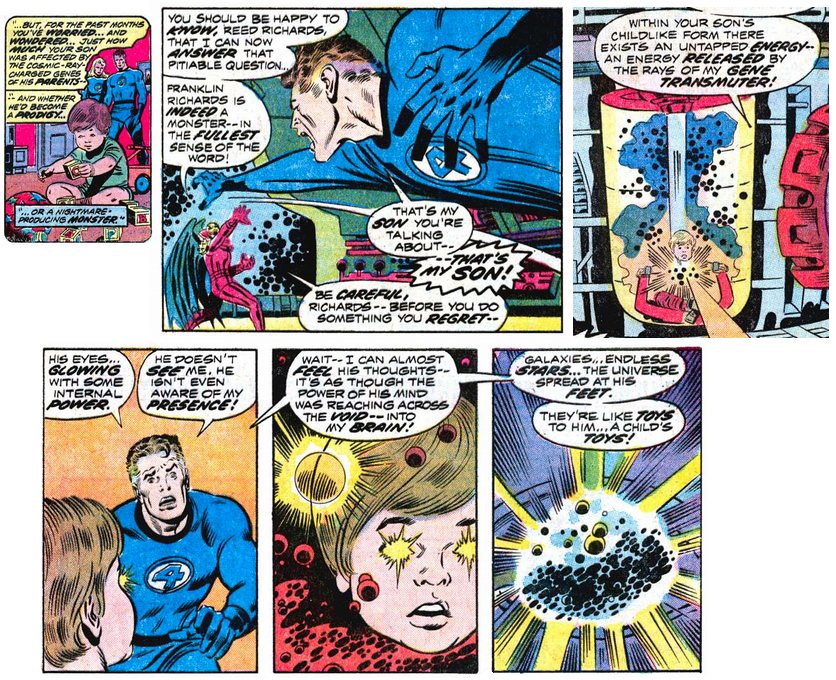
This is the big one: where we learn the full extent of Franklin's
power. it is also where Reed zaps his son into a coma.
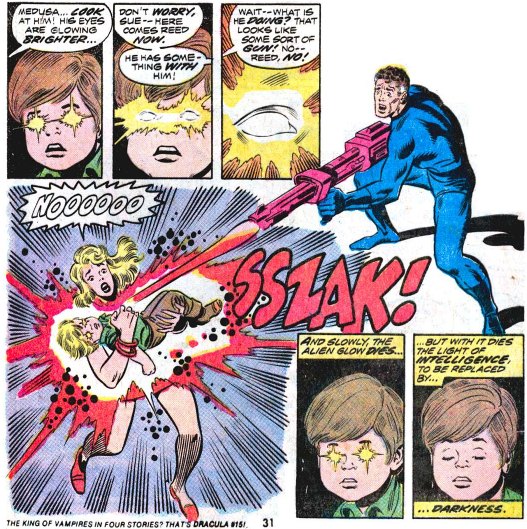
Why do the team walk out?
It may seem unfair that the team walk out after Reed saves the
world. Note that Medusa stays (next issue). The difference is that
she has only seen the recent events. The others can see this event
in context. If seen in isolation, Reed did the only thing he could.
But seen in the context of Franklin's life, Reed should have spotted
this earlier. Annihilus did not suddenly produce that energy,
it was always there. Why didn't Reed notice? Energy and the
negative zone are his specialty. But for all of Franklin's life Reed
has pushed him away. Reed wouldn't even let the child have a name
for several months (over a year, our time). The others cannot know
whether zapping him was needed or not, but they do know that Reed
has always pushed his son away, and this is the last straw.
Why has Reed always pushed Franklin away?
Reed's excuse has always been that Franklin would be safer away from
them. Yet Agatha just kidnapped the child for Annihilus! What other
choice did Reed have? Well Sue's force field is perfectly designed
to protect him, and the Baxter Building has its own defenses. Then
why does Reed push him away? Clearly he is uncomfortable around
children. Reed just isn't touchy-feely. It's also possible that he
unconsciously sees Franklin as a rival for Sue's love. but he seems
happy for Sue to stay behind with the child, so it's probably just a
case of feeling awkward. Children and advanced science do not mix.
Or so Reed thinks. This is not to say that he wanted to zap his son.
He didn't want to! But the dilemma could have been avoided if he'd
paid more attention in the past.
A historic and unforgettable issue
"This period of the
FF’s history had a very strong effect on me. I was around nine
years old when these issues came out and I recall being very
disturbed by what seemed to be the disintegration of Marvel’s
first family. Sue had already left Reed (back in issue #130)
because she felt he was both neglecting his duties as a husband
and father, AND treating her like an inferior. The team limped
along without her, as Medusa came to fill-in for a time. It just
felt really wrong. I had been reading the FF reprints in
Marvel’s Greatest Comics at the same time and the contrast
between the happy, stable family from the past and the
fractured, miserable family here was shocking. As a child, it
made me feel very insecure. So when Reed actually used his
anti-matter gun to shut down Franklin’s mind, I remember being
just stunned. This truly was one of those comics moments that
had an impact on me. " ( - Karen in "Two
Girls, A Guy, and Some Comics")
Was Sue a weak female before that? No, but she gave Reed his
chance to do thing his way until even he could see that it wasn't
working. For more about Sue as the strongest member even at the
start, see her own page. Some
have argued that Sue should be read as weak because Stan Lee wrote
all his females as weak, see for example Jean Grey in the X-Men,
who often had to be told what to do. However, Jean is a special
case: when she died it was revealed that she was born in 1957,
making her just seven years old when she joined the X-Men. Mutant
powers usually exhibit in puberty, and her mind based powers
apparently caused her puberty to kick in very early (it is
possible to hit puberty that early, but extremely rare).
So Jean Grey was a child and did need coaching. This also explains
why Cyclops held back despite his obvious attraction to her.
Criticisms
- Why did Annihilus need the whole team when he already had Franklin?
Annihilus explains at the end of F140 that they are the final pieces in
the "dimension spanning puzzle" of how to get ultimate power: that
power comes through Franklin, and apparently Reed and his parents are
needed for that. In F140 He says they must be rested for the transfer of
power, and we see that Sue has to be close by. It appears that
Franklin's mind has unconscious barriers that are only lowered by the
presence of his mother. Revenge also comes into this: just as with the
Miracle Man, this pettiness causes Ben to lose any respect, allowing him
to lower his own mental restraints and use all his power (see Ben's own
page for how his fear of hurting others normally holds him back)
- Their powers appear to come and go?
In the tower, why does Medusa have her power while the others do not?
Annihilus' whole plan was to drain the power of the Fantastic Four:
Medusa, not a member of the original team, was obviously not part of his
plan.
- Why do their powers then return?
Reed explains Annihilus has been losing power, and he is not "done with us". With his attention elsewhere, their powers return.
- How can Ben defeat Annihilus with one punch, when before Annihilus was so strong?
As noted, before that Annihilus was draining their power. At full power, when unrestrained, Ben is immensely strong.
Annihilus has just told them that his exoskeleton is the strongest
material in all universes, and that he can explore the hearts of suns.
This is Ben's assurance that he can hit without holding nothing back,
Also, Annihilus was in the middle of absorbing Franklin's power: this is
like absorbing nuclear bombs - a highly delicate process where one
wrong move would put Annihilus out of action.
- Is Agatha Harkness inconsistent?
Why does Agatha not try harder to defeat Annihilus? Agatha is not a
hero. She meas well, but Reed's decision to entrust Franklin to her is
one of his most serious mistakes. Reed has persuaded Sue to trust
Agatha, but we see in this issue that Agatha is easily controlled by
Annihilus (due to her affinity with links between dimensions, making it
easier to contact our world through her).
- Why does Agatha appear powerless at one moment, yet is then able to transport seven people across dimensions?
The Negative Zone is accessed via sub-space, the place that joins
dimensions: for somebody versed in magic, transporting people from the
Negative Zone back to their natural home would take less energy that it
appears. Transporting them the other way, or to a non-native location
(e.g. getting Annihilus out) would be much harder.
Other points to note
Franklin controls everything: why didn't he stop this?
Franklin wants to be at the ranch
In FF134, Watch Franklin carefully. It is as if Franklin wants
Dragon man to capture them, so they can be de-powered and be like the
happy ranchers he saw where his mother was happy. Note that Dragon man
is always the symbol of marital tension, and a messenger from higher
powers: see the notes by FF35 and annual 16. In FF142, being zapped
brings him back to the the ranch where he is happy.
Agatha is behind this
In FF143, Frank is asleep during Doom's great plan. This is the climax
to all of Doom's plans, the one that would finally enslave the whole
world. Yet Doom acts slightly insane, and makes poor decisions, e.g.
laughing as he forces the spies to kill each other, provoking Darkoth,
and not noticing the approach of the FF. This saves the world. Here is
the evidence that Franklin affected his mind:
- This is big
This is not just another attempt to humiliate the FF, but Doom's most
audacious plan since stealing the surfer's power (which happened before
Franklin was born so he could not help). - Agatha Harkness would notice.
The plan involves highly advanced technology: crystals for global mind
control: Doom's standard operating procedure, and why he can do so much,
is that when needed he combines magic and science. Crystals are the
hallmark of technology that borders on the magical. So a sensitive
magical being like Agatha would notice. - Agatha's greatest power is Franklin
We have seen before that Agatha's power, while impressive, is limited.
But the whole point of magic is to access unlimited power. Probably
Agatha influenced Reed to gain access to Franklin for precisely this
purpose. - Agatha is not innocent
Agatha has persuaded Reed that she protects Franklin, but here and at other times we see that this is not true. - Nicholas Scratch
Agatha comes from New Salem, a whole town full of witches. These are
people who deal with the same forces that Dr Strange uses. On two
occasions we see that the whole town desires to rule the world, under
Agatha's son. Of course, when he fails the others claim they were merely
victims, but is that really likely? When Scratch fails, Agatha sends
him to the negative zone, from where he tries to control Franklin (see
FF222). This is too much of a coincidence.
So Agatha is nurturing Franklin for her own purposes. Doom is the
biggest threat to Agatha's plans, so must be stopped. Franklin is the
obvious way to do that. This is part of the bigger story of how Agatha
became Franklin's nanny, despite putting him in danger. Agatha needed
Franklin for her battle against her son. Reed, the scientist, has no
idea of complex magical politics and was easily led.
What was Agatha's plan?
While Franklin is asleep (FF141-150), every story is about mind control:
- Annihilus weakened the team's will, allowing him to gain
Franklin's power (When the mind control was absent he was easily
defeated by Ben). So is Annihilus really controlling Agatha, or is he
her unwilling pawn?
- Doom planned to control all minds
- Maximus rescued Ultron in order to mind control everyone.
We do not know the details, so can only speculate. But this is a
prime example of the magical battles that take place below the surface.
Franklin is asleep, and there is is a battle to mind control the world.
What is Agatha's ultimate goal with Franklin?
Franklin's power to end the universe sounds like the ultimate nullifier:
was he to reset reality to an earlier time, perhaps before mankind
gained superpowers? But in the Franklinverse, he actually created
universes: was FF141 really Agatha's plan to create a universe? Or to
rip through this universe to a higher one? After all, magic is about
gaining power form higher beings. What more natural goal than to enter
their realm as an equal?
Again we do not know the details, but the closer we look at superhero
stories, the clearer it is that great battles are taking place between
advanced beings, and those who envy their power. The power is so
advanced that we call it magical or cosmic. These are the battles that
we never see, and the superhero battles are only a side effect.
142
Issue 142: the family's first major test
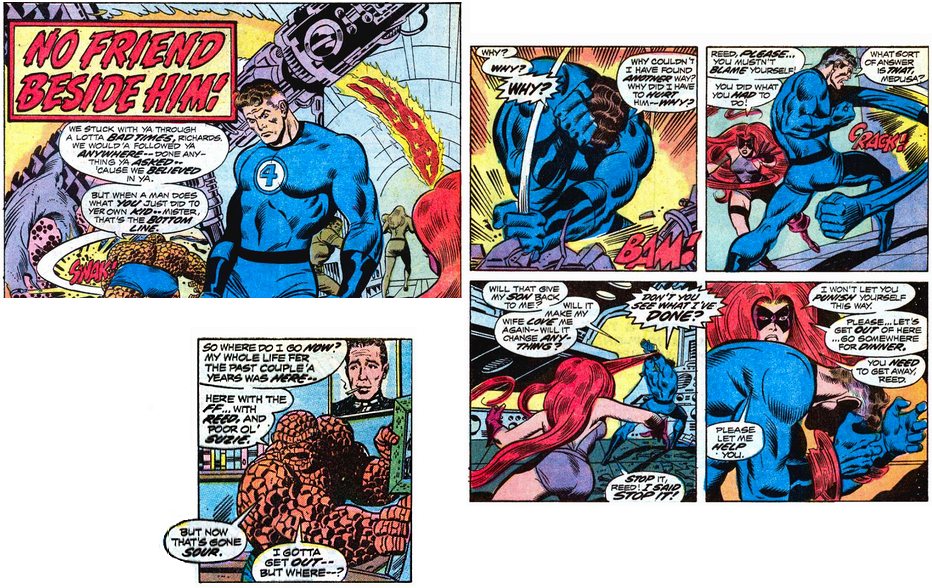
This is the first time the family has broken up (if we don't count
FF72, which didn't last even a single train journey.) They do reform
they find that they need each other, but Reed's problems are not
solved and in FF190 they break up again. That time they think
they've solved their problems but it turns out to be a false dawn.
However, they do learn that simply breaking up doesn't solve
anything.
Ben and Johnny were never happy in the team. This is their
opportunity to get out. Wyatt is a friend of Johnny and he knows
this is not the time to interfere. But Medusa doesn't know Reed's
history so she supports him. Plus she always felt Crystal was too
emotional, and the Inhumans are not known for being emotionally
sensitive to their children, so she would probably side with Reed
anyway.
Timing, and Reed's autism
After the dramatic opening event we follow Ben for well over 17 hours
before seeing Reed react. This delay adds to the realism: when something
terrible happens we need time to process it. Reed probably did not
sleep, but was silent, in mental turmoil, not knowing what to say: he
was convinced he did the right thing, now he does not know what to do.
In that time he is unable to communicate. This is classic autistic
behavior: being unable to cope he withdraws, until finally the inner
pressure builds up and he has a meltdown. Medusa knows that staying
withdrawn will not help: he has to get out and meet people.
Other points to note
- I love this issue
Speaking personally I love this issue. Lovely art, interesting
locations, and I love Darkoth. I had this issue on its own for
years before seeing what came before and after: it made me want
more!
- Rich Buckler's first issue
Rich Buckler describes how he got the job as artist:
"I got word from Shel Dorf (of San
Diego Comic Con fame) that Jack Kirby was scouting for inkers on his new
books he would be creating for D.C. Comics. Well, I never really wanted
to be an inker, but I couldn't pass up the opportunity to try out for
this. I inked some Jack Kirby photocopied pages that Shel supplied me,
tracing them on a light board. I gave these pages to Shel, along with a
half dozen sample pencil pages of mine, and he forwarded everything to
Jack. I didn't think I had a prayer, but hey!--I could dream, couldn't
I? I was still living in the suburbs in Detroit at that time (Jack Kirby
had just moved to California). Imagine my reaction when weeks later my
mom answered the phone and she said it was for me. 'Who is it?' I asked.
'I don't know. Somebody named Jack Kirby.' Well, you can probably
picture me stammering and almost totally 'brain numb' as I nervously
held the phone and spoke with my biggest idol (sounds like slobbering
hopelessly obsessed fan-boy stuff on my part, right? Well it was!). What
I remember from the conversation (and he was friendly, warm and
effusive) was that, no, he didn't think my inking was quite up to what
he was looking for. It didn't suck--it just wasn't up to professional
standards. But he was impressed with my pencil samples. I could hardly
believe what I was hearing when he said that if I were ever to visit New
York, that I should look up Stan Lee--and that I should 'tell Stan that
I said to give you a job!'" (source)
Soon Buckler had a young assistant who would rise to even greater heights: his name was George Perez.
- Star Wars
There's a scene in the Empire Strikes Back (which war released
several years later) that is suspiciously like the end of this
issue. The heroes come to get help in an exotic location. Then
they open a door and shocked to see Doom/Vader at the head of
the dinner table. (There's also a similar scene in FF87, but in
that case they knew they were in Doom's castle: FF142 is
closer.) Did George Lucas read the Fantastic Four? Given the
similarities between Doom and Vader (costume, science and
mysticism, storm troopers. number one bad guy, etc.) Lucas would
never dare admit it. (The Fantastic Four phrase "not quite, sir, there is
one other" is echoed by Yoda, also in the Empire Strikes Back.
But that may be just a coincidence.) For this and more Star Wars parallels, see the page on Lee and Kirby, how Kirby was ahead of his time.
143
Issue 143: slavery (and for the first time, Sue is alone)
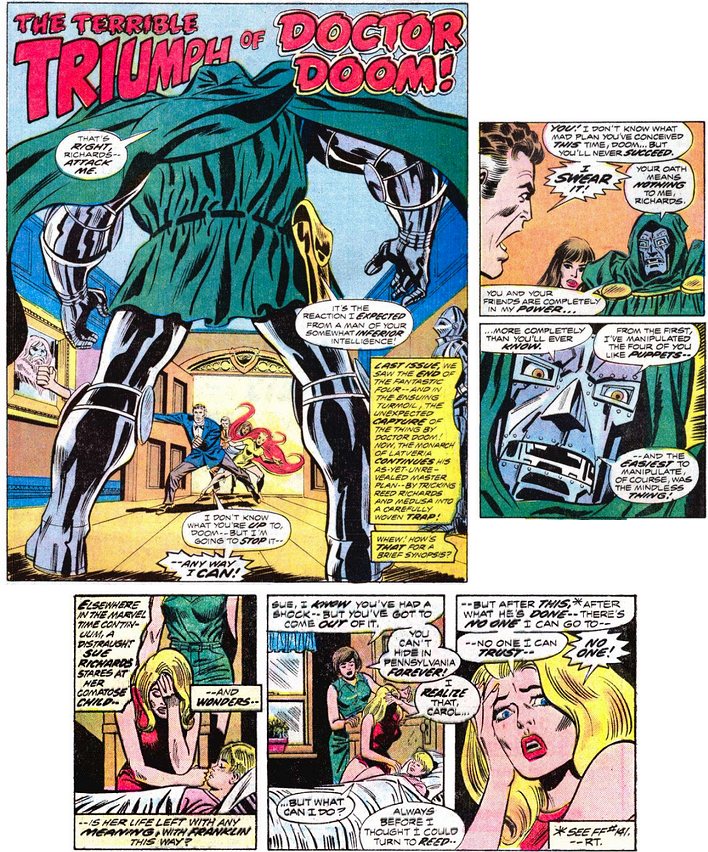
Sue has never been alone before. She relied so much on Reed's
moral strength when her father went to prison (see notes to
FF140). What can she do?
Who can she trust? Compare FF261
This is one of two times when Sue's marriage became so bad that she
ended up in the arms of the Sub-Mariner. This time is because Reed acted
in passion The second time is because all passion died (see the start
to FF 261, following on from an adventure with Namor). In FF250 Sue is
determined to never leave Reed again (see her comment at the end of FF
289), but staying in a loveless marriage is arguably worse. Reed will
not put Sue first until act 5, when the marriage is finally healthy at
last. Sue and Reed's marriage is the barometer of the rise and fall of the FF in acts 3 and 4.
Slavery
Reed and Sue feel trapped, and these four arcs deal with enslaved groups.
- The 1950s story featured race relations.
- Then the Miracle Man story featured native Americans, forced to live on small reservations.
- Then the Annihilus story gave his background as an insect among
animals. Animals are the last group to remain enslaved, and among
animals, insects are considered the lowest form of life (despite being
more successful than humans).
- Here we see Doom's need to enslave the human race, the results of
slavery in Eastern Europe, and his enslavement of the African American
Desmond Pitt as "Darkoth". It is fitting then that the focus of this
issue is Ben, the one enslaved by his skin, the Jewish street kid, the
strong and intelligent adult treated like a child by Reed.
Why Darkoth?
(A short history of Doom and his robots)
Darkoth is part of the natural evolution of Doom's robots. Their
gradual progress is a motif that runs through the 28 year story. Robots
are part of the theme of control (Reed and Doom are obsessed with being
in control, and they finally gain wisdom when they learn that
cooperation is more effective than top down micromanagement). Doom's
advances in robots are paralleled by Reed's advances in his home:
Doom shows the folly of wanting slaves, whereas Reed gets closer
to the truth (the home is what matters) yet still fails to see the
power of his family until act 5.
Darkoth and racism
It is significant that Darkoth is a black man (the clue is in the name),
but his history is not revealed until his next and final appearance. An
enslaved black man reminds us of America's past. To white racists, only
white men are in the image of God, blackness represents evil, and that
native African religion is demonic.
Eastern Europe and superstition
Doom relies on local superstitions to make people fear Darkoth. These
superstitions of the Eastern European mountains remind us of the book
Dracula. The existence of superstitions reflects a rational reliance on
rumor. Superstitions grow whenever there is great danger and little
information: it pays to assume that every rustle in the grass is a tiger
and every shadow in the dark is a death demon. Slavs have a long
history of not having information or freedom: they were effectively
slaves, treated like dirt, for thousands of years. Indeed, the word
"slave" comes from the word "Slav".
The Zeitgeist: James Bond
The Great American Novel reflects everything that is popular in American
culture. Int he 1970s James Bond became popular, so naturally we have a
story that pays homage to the famous tropes. As FF1by1 puts it,
"generally accepted as the clichéd comic book/James Bond villain plot.
Doctor Doom wants to rule the world, he has a weapon of a very
scientifically dubious nature, and he has assembled and imprisoned his
enemies (the good guys) in order to humiliate him." But far
from being a typical Dr Doom plot, this is the first and only time he
has done something so silly, and it reflects his emotional state at the
time.
Criticisms
- Why is Doom's plan so overly elaborate?
As noted in the page on realism, when
both sides have advanced weapons the purpose of battle is not simply
kill the other side (as that would be suicide), but to demoralize them
so they give up. The enemy strategy is always to humiliate. This is
especially true of Doom with his huge ego: he has to prove he is
superior. This is Doom's lowest point, so he makes the most effort to
prove he is better, creating an elaborate and complex plan to remind Ben
of his desperation (by hitting him through his weakness) and remind
Reed of when he was at school with Reed. Part of the attraction of this
plan is that Ben and Reed are given clues: both are summoned to the
borders of Latveria. when they miss those clues it reassures Dom that he
(Doom) is their smarter than them. But the very complexity is evidence
of Doom's weakness at this point.
Other points to note
- Doom and Ben
Although Reed is Doom's classic enemy, here Doom is more concerned
with Ben: Ben humiliated him and FF40 and again when he had the
surfer's power. Being beaten by someone he considers such an
inferior is galling.
- Doom's lowest point
At this time Doom is at his lowest point. He hasn't been paying
much attention to his people, the source of his power. This "end
of the world" scheme feeds his ego and his resentment, but he
hasn't planned it well, and is defeated. See Doom's own page for where this
fits into his character development. Deceiving Ben, rejoicing in
the two spies killing each other, and needing the approval of
the masses indicates just how far Doom has fallen.
- Doom mirrors Reed
Doom's plans fail because Darkoth is horrified and
leaves, just as Reed's plans failed when his friends were
horrified and left.
- Technology
Note the similar uniforms in FF67 and FF143:
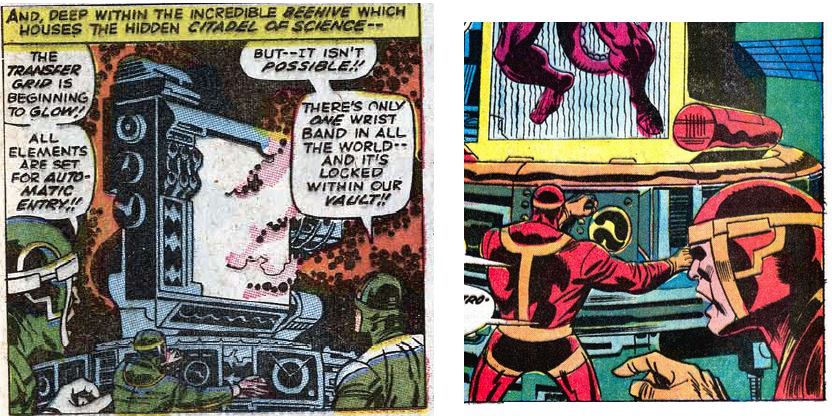
The costume similarity cements the link between "Him" and the cyborg
Darkoth, and Doom's next step in robot development, his Doomsman a few
months later. It looks like many of the Enclave scientists escaped and
continued their "perfect research" work under Doom. Specialist
scientists are hard to find. Thanks to "Shar" of Panelocity for spotting the link.
144
Issue 144: Doom's half way point
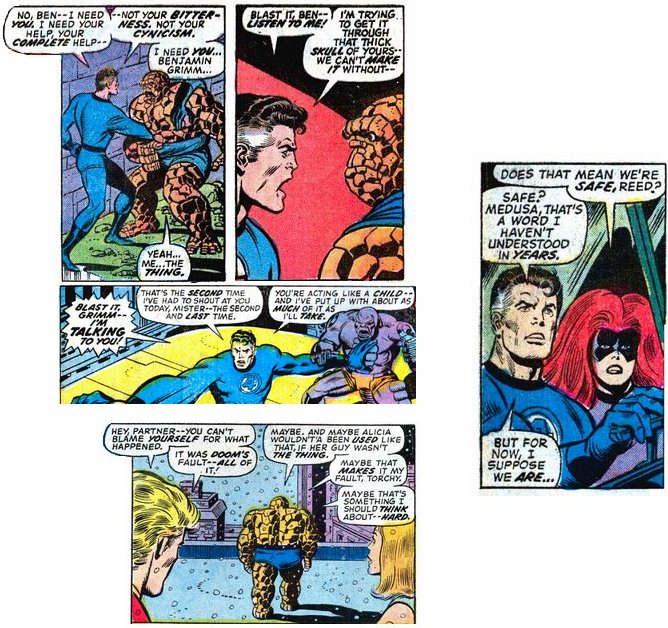
Still Reed cannot say sorry. Ben is hurting, and instead of facing
what he has done, and treating Ben as an equal, Reed just condemns Ben.
Ben's confidence, briefly
raised when he left Reed, takes another pounding when he's back.
Reed says he hasn't felt safe in years. A minor clue, but this may
be further evidence of autism. As Temple Grandin tells it (in the
BBC Horizon program "the woman who thinks like a Cow") to be
autistic is to be like a prey animal, always to feel surrounded by
constant danger.
Note the snow at the end: a metaphor for the coldness in their
hearts. Next issue the cold deepens.
Doom's turning point
Doom behaves poorly?
This issue is often criticized as a poor story about Doom, because (1)
he behaves poorly, and (2) his attack seems badly planned. But look
deeper and this issue may be one of the most important of all.
As always, the subtlety of the main characters' lives is reflected more
clearly in the people around them. This is the lowest point in Reed's
relationship with his family, and so it is reflected in Doom's lowest
point in his relationship with Latveria:
- He blames others when he should have planned better
- He behaves like a child (see below)
-
He laughs at making traitors kill each other. A more responsible
Doom would see the weakness in such pettiness. A more aware Doom would
recognize traitors as his own failing: why are the people so unhappy?
Because he neglects them.
Doom's bad relationship with Latveria in the mid 1970s point is explored more fully in Super Villain Team Up. See Doom's own page for the context.
Why this particular issue matters
This story is important because it shows that even when he has
everything going for him - a satellite from which he can rule the world -
without the nobility that comes from loving Latveria he is nothing.
Childishness - a theme
Twice in this issue Reed treats Ben as a naughty child. The
second time he explicitly says Ben is like a child. Yet Reed caused the
problems himself.
- The first conflict with Ben, in the sewers, is because Ben has
lost all respect for Reed, due to Reed's actions over the previous
years. So Ben is quick to believe that Reed is lost when Darkoth
suggests it. And how does Reed plan to solve that problem? By insulting
Ben. He could say "I accept I have made mistakes, we will discuss this
later" but instead he says, in effect, "you are stupid, it's all your
fault." Now who is childish, Reed?
- The second conflict is when Reed is dismantling the android: Ben
is on edge because of Alicia, his distrust of Darkoth, and his lack of
respect for Reed. The final straw is "all this waiting". Medusa agrees.
This is poor leadership. Reed is acting like a one man team again. Is
there really nothing the others can do? Fair enough, perhaps they had to
stay in hiding, but he could have told the others to brainstorm:
Darkoth's knowledge of Doom would surely spark some idea in Ben or
Medusa. But Reed had not treated others like children for so many years
that their mental abilities are wasted.
Childish Doom
Doom, as his name suggests (domos, home, see notes by FF5) relies on his
connection to his homelands for his identity. Growing up as a gypsy,
without a formal nation, he needs his connection to his people. Without
it he is emotionally an orphan. Hence at this period he acts like a
child: laughing at the errors of others, getting over-excited at silly conquests.
Coach Thorne
Why is Coach Thorne needed? Because, in his childish state, Doom needs
the approval of his old teacher, the one who did not respect him. When
Doom regains his dignity, his connection to his people, he will no
longer need to seek approval. A mature person needs to help others, and
needs their feedback, but does not need them to tell him he is a good
boy.
Doom as a mirror of Reed
Doom is once again a mirror of Reed. Doom is low, and so is Reed. Reed
neglects his family and Doom neglects Latveria. Both have the same
weakness: they treat others as inferior. Doom's low point is symbolised
by his great power being impotent. His most dramatic achievement is to
pulling a building into space, as in issue 6. Here he shows off by doing
it again, but it just blows up. Here he doesn't even have the
satisfaction of a worthy opponent like Namor (in FF6), but he is beaten
by one of his own creations: he cannot even control those he
creates! This foreshadows Reed's similar weakness at the end of
act 4, where he allows his home to be destroyed in a petty act: at the
end of act 4 even a second class Doom will be more capable than Reed.
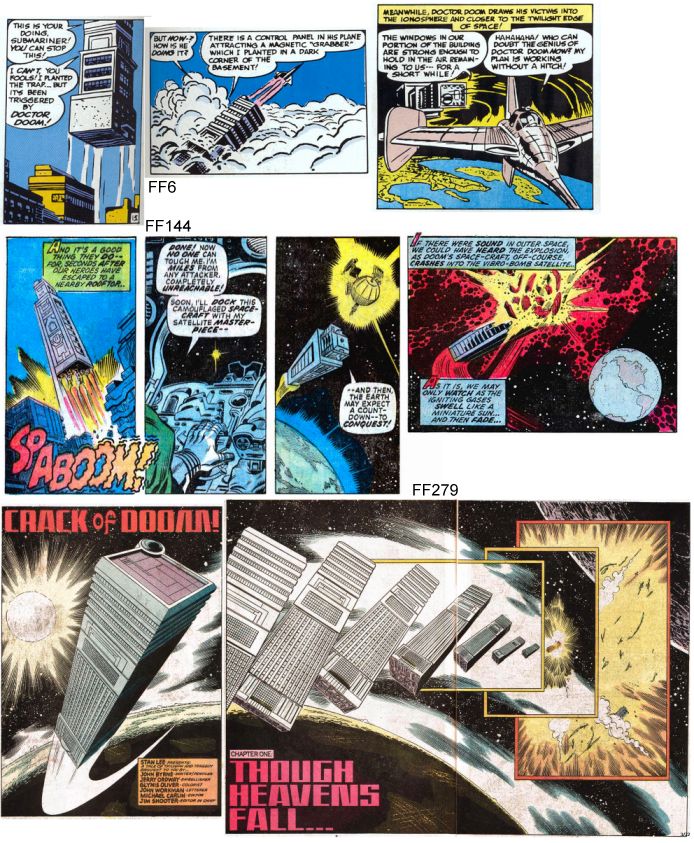
Badly planned?
At the end of this story the bomb goes off, priming everybody in the
world to obey him, but Doom loses the satellite and its equipment so he
can't make use of that, and the world goes on as usual. This appears to
be an anticlimax, a proof of poor planning by Doom. But was it?
True, Doom was defeated, but the bomb still went off. This may be
important in the long term story. It helps to explain why, with the help
of the Purple Man, Doom was finally able to control everybody in
Emperor Doom, the point where he finally learns wisdom. In Emperor Doom,
a machine channels the Purple Man's power into the atmosphere, so that
Doom can control the whole world. We are not told exactly how Doom could
expand that power, other than it uses a crystal. But FF144 provides the
explanation: the people were already primed. Compare the design of the
device in FF144 and Emperor Doom: they are essentially the same.
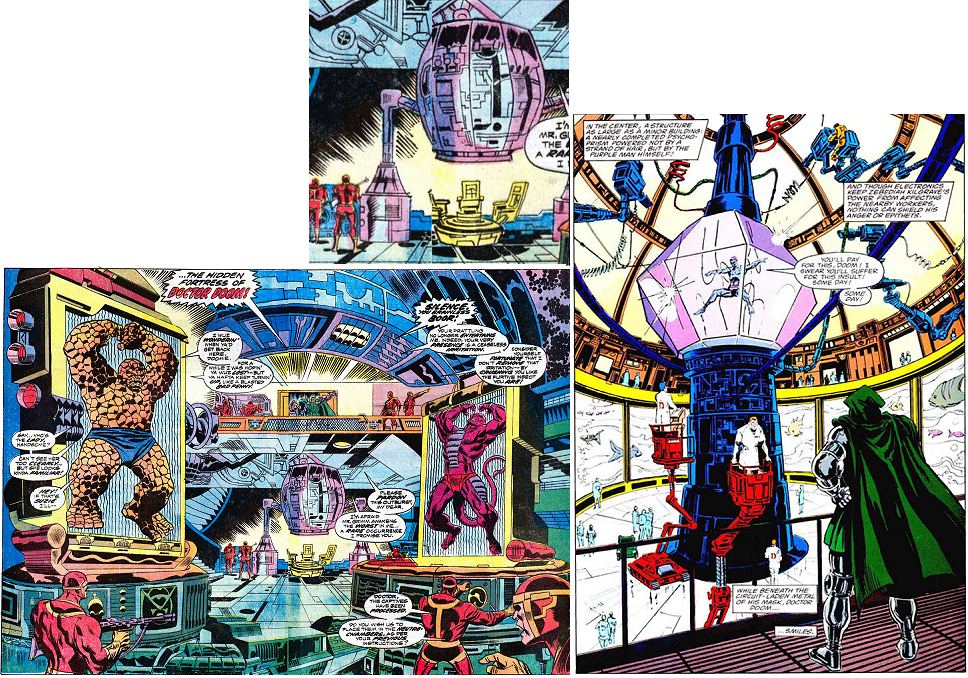
So Emperor Doom completes what FF144 began. Put simply, without FF144,
Emperor Doom is less plausible and so his whole 28 year arc fails.
Doom's half way point
Super Villain Team Up and Emperor Doom are not essential to understand
Doom, they simply provide details. But the general shape of the arc is
covered in the main FF title on its own. Regarding the end, Doom's
wisdom begins in FF247, and annual 20 reflects the events of Emperor Doom
(see the notes by annual 20). Within the main title, FF144 is in fact the half way point in Doom's
story arc. the date is 1974, half way from 1961 to Emperor Doom in 1987.
It has the central element of his first story arc (FF5-6): taking a
stone building into space (symbolizing his combination of scientific
marvels with his love of old stonework - see his castles and Latveria).
It also has the central element of his final great arc, the purple
crystal device to brainwash the world from space.
Rich Buckler, Kirby, and hidden depths
The Great American Novel says things with images as well as words.
At this period Rich Bucker (the artist) was encouraged to draw like
Kirby. So he used Kirby's images to reference earlier times. Each
Buckler event is linked to a Kirby event. The pictures add depth to the
story. Buckler used this method throughout his run. I shall just use
FF144 as an example, but for other issues visit the "panelocity" blog at
panelocityhomageswipes.blogspot.co.uk. Thanks to Sharon for putting in all the work.
Here's the first example: why is Ben so on edge in FF144? Why does he mistrust somebody who Reed
trusts? Why so irritable? It's not just Reed's behavior from FF241. Look back at
Ben's memories: he has good reason for his feel like he does:
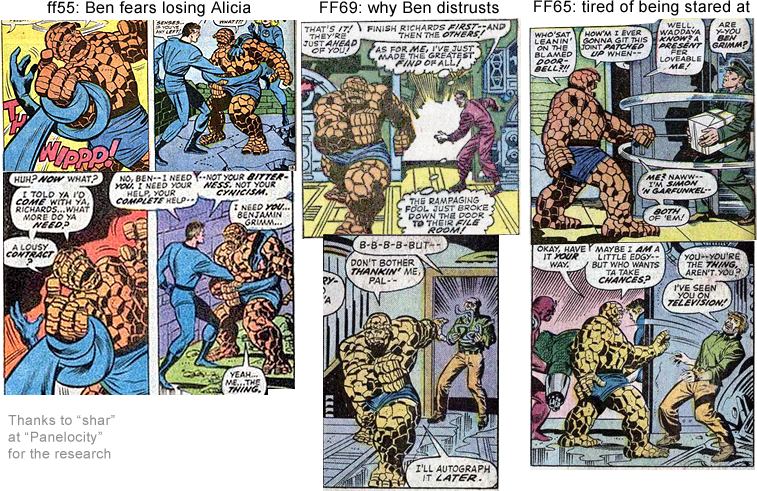
Next, is Reed really the natural leader he appears? On the surface, Reed
is like an adult and Ben is like a child. But look at the characters'
memories: they remind us that Ben is var more powerful than anyone
realizes: like Blastaar, he is astounding in his abilities. Reed makes
him just stand around doing nothing for most of the issue: Reed is
wasting one of his greatest resources. It should also be noted that
Ben's stubbornness, and his history with Doom, mean he might be able to
withstand the mind control: there are a lot worse ideas than just
letting Ben storm in and smash things. Being so ion edge about Alicia
this is the one time when he might overcome his natural holding back and
really let rip. But Reed cannot see Ben's strength. Reed cannot see how
much eh relies on others: Ben saving Reed from the nuclear robot should
have reminded Reed of when Triton rescued him. (Triton of course was
originally considered an enemy until Sue saved his life, thus turning
the Inhumans into friends and changing the course of history.)
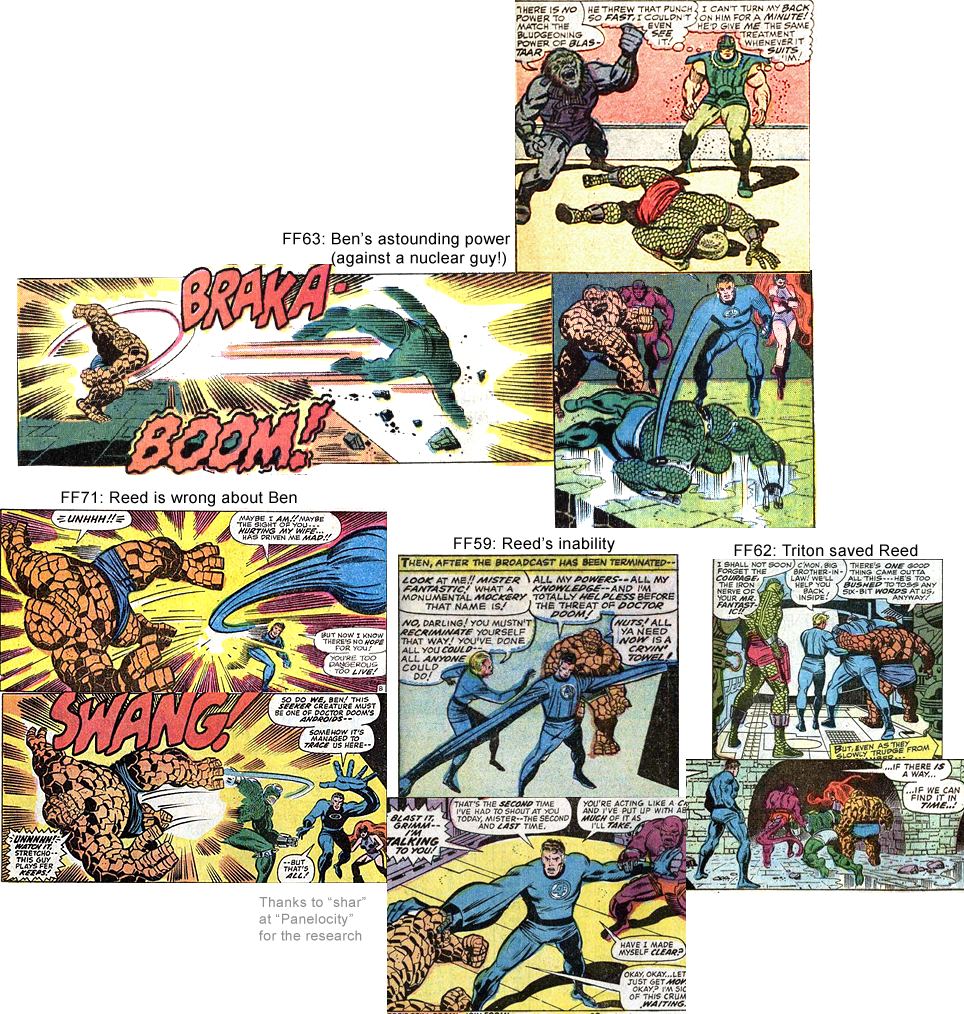
Next, why is Doom so keen to control others? Because he feels like the
whole world is against him. Like the Mole Man, he is afraid of what
others might do, and wants to weaken them all. When seen in this context
we see the folly in his words: no matter how strong Doom is, if he
weakens the rest of the world then he rules over a weak world. And of
course Doom is not as strong as he thinks: but like the Mole Man, he
cannot see clearly. Speaking metaphorically, he wants to blind others
because he is blind. Like the scared, hiding Me Man he hides behind
giant machines and monsters of destruction.
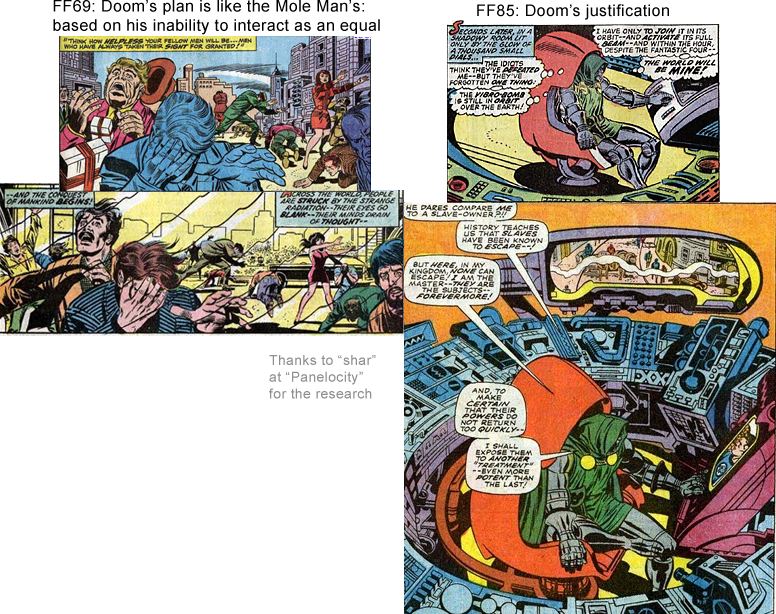
Finally, the ending of the story: they have achieved only a temporary
victory: in the long run, their conflicts are a never ending cycle of
despair. When the other players are so intent on distrust and conflict
then the only wise choice is the one that Sue has chosen: do not even
play the game. Note Johnny's pose: as the youngest, the one raised by
Sue, he still as optimism. The next generation will rely on him.
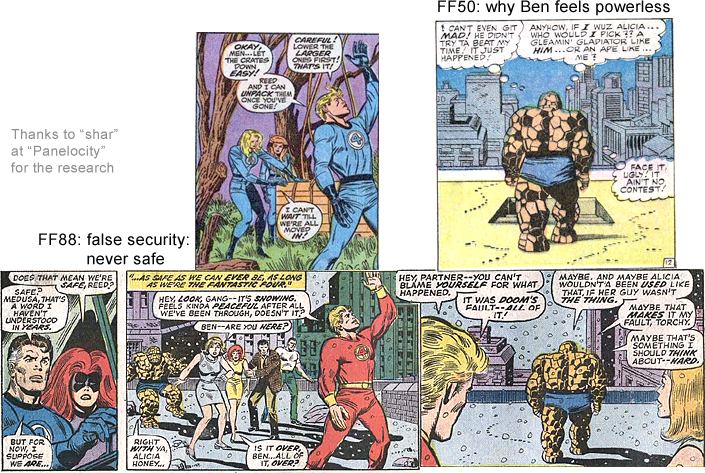
Note that several of these memories (FF50, 69, 71) are linked to other times when Ben felt he had disappointed Alicia.
Note the Shakespearian touches throughout:
- the tragedy of Reed and Doom being trapped by their own weakness
- the symbolism of blindness
- the prince in waiting (the only innocent member of the royal group is Johnny, but he does not yet have the wisdom to lead)
- we can see layers that others cannot see (how Doom will come to
see that he needs others, even though he will deny it: see commentary on
FF247 and annual 20)
- people in disguise (Reed as the nuclear robot; and all this time Ben does not recognize his best friend - see FF293)
- a location apart from civilization (the sewers; outer space)
- the weather reflects their moods (and foreshadows the next issue)
- etc.
Criticisms
- The second launch:
Why does Doom need a second launch to be with the vibro-bomb? Why not go
with it in a single journey, or control it from earth? The clue is in
the name: it's a bomb. You do not want to be in the same rocket as a
bomb that's in the process of detonation. But once it is safely
working you want to be close enough to observe its results.
Other points to note
- Medusa's costume:
In the footnote about Medusa's costume, the joke about it being
"compressed in a secret ring compartment" refers to DC's Flash. (thanks
to Mark Drummond for pointing this out on another site). This underlies
how realism is more important in the FF than in the Flash. Why the
Flash? "The Silver Age began with the publication of DC Comics' Showcase
#4 (Oct. 1956), which introduced the modern version of the Flash."
(Wikipedia) As for the realism of Medusa hiding her costume, she has
advanced Inhuman technology, and in FF150 uses a device that changes
costumes according to need, so the costume change is not really a
problem.
- The mind control bomb:
Applying Occam's razor, there is no need to assume multiple mind control
devices when one will do. See the notes to FF8. The simplest
explanation is that the robot in FF7 left many of these devices behind,
the Puppet Master found one, and Doom found another. Possible Maximus's
many mind control abilities are based on the same devices. Note that the
hypnotism used in FF3 is something different: the Miracle Man had to be
personally close to a person in order to plant an idea in their head
(even if it was not triggered until later, such as when watching TV).
The Miracle man was closer to being a regular hypnotist.
- The flying building:
Again, applying Occam's razor, this would have used the same device used in FF5 and FF279.
- Literary quality:
"There is also an interesting duality in the resolution of this story
[...] Reed is able to gain an edge on Doom from a distance (he isn’t
even present in the final assault) by wiping and re-imprinting the mind
of one of Doom’s cyborg creations and sending it back at him. This is
pretty near exactly what Doom aims to do to the rest of humanity. There
is a very complex morality in Reed that causes him to allow one of
Doom’s creatures to rebel while using the other one in exactly the same
way that Doom does. Where is The Seeker’s rescue and rehabilitation? Why
can he not be saved when Darkoth can? Or is Reed just as locked into
the dance of fixation and destruction that Doom is?" (source)
145
Issue 145: Johnny can't see what he did wrong

Reed was a father figure to Johnny (his own father was in jail and
he was raised by Sue who doted on Reed). So it's not surprising that
Johnny is not sensitive to others and has trouble seeing his own
faults. Johnny's betrayal of Crystal is
cataloged here. Johnny won't know how to have a healthy,
sensitive adult relationship with women until Alicia changes
everything. See notes to FF204 for his disastrous love life. This
difficulty in dealing with others extends to his relationship with
Ben. he took out his frustrations on Ben, and as Medusa says, when
Ben hit back, Johnny had it coming to him. Then, just as they are
about to discuss feelings, just when Johnny might learn something,
Reed interrupts. Johnny will one day learn to be sensitive, but Reed
is a much harder nut to crack.
Other points to note
- Literary quality:
The Fantastic Four is a guide to all the most interesting
ideas in the world. So we had to get around to yetis sooner or
later. And next issue we have the meme of wise monks on
mountains in the Himalayas.
- Yeti technology
Where did the monk (and through him the yetis) gain advanced technology?
Almost certainly from the Inhumans. The monastery was there for
centuries, very near to the Inhumans' highly advanced city. Note that
the climax to this story (next issue) is the use of a mutating ray:
mutation is the Inhumans' signature technology. Recall that when Lockjaw appeared the locals knew of him as a legend, so
peripheral outside contact was normal. Obviously at some point over the
centuries the Inhumans would crash a vehicle or abandon an outpost, or
perhaps even make deliberate contact. Any warlike yeti would make it his
life's goal to obtain as much Inhuman technology as possible, as this
was the quickest route to conquest. Alternatively, the Inhumans may have
experimented on this group for their own curiosity: in this issue we
learn of "project revival" (the secret reuniting of Reed and Sue), so
the Inhumans do secretly get involved in the outside world when it sits
them.
146
Issue 146: climate change
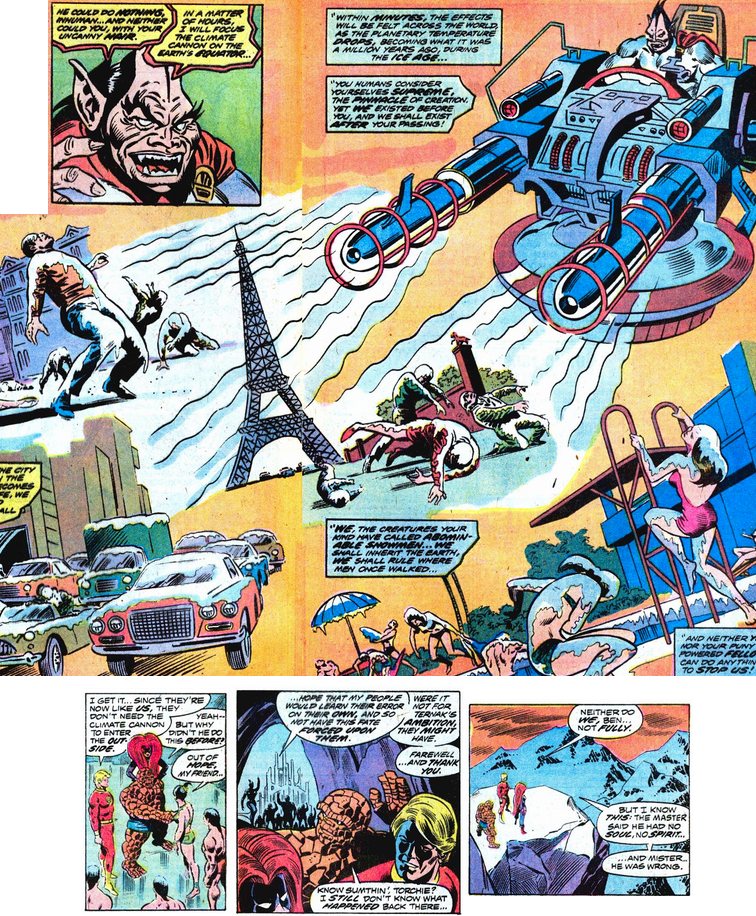
This is the Great American Novel, and climate change is a major
global concern, so it features here. Of course, back in the early
1970s the big fear was of an ice age, not global warming. The ice
can also be seen as a metaphor for the lack of warmth in the team.
Note that the monk sees interference in another nation's affairs
as a cause for serious regret. The Founding Fathers felt the same
way, and wanted isolationism. Medusa, one of the isolationist
Inhumans, agrees. but Johnny represents the younger generation in
America and sees nothing wrong with getting involved in other
nations with the intention of making the world a better place.
This is a big issue in climate change: it has to be a global
effort, but can one nation tell another nation what to do?
The ice queen
Note the symbolism of this issue. Medusa is the queen of the Inhumans,
and is known for her icy control. When Crystal wanted to leave, Medusa
condemned her for showing emotion in public, yet Medusa can be a
seductress when she wants to be (see her first time with the Frightful
Four). Medusa speaks for Black Bolt, yet does not always reflect what he
wants (compare FF306 where she says Crystal must leave, and annual 21
where Black Bolt wants her to stay). At this time she is secretly
planning Project Revival. Medusa is icy cool on the exterior.
The hot head cools down
Note the symbolism of ice for Johnny's character development this issue:
Johnny was critical of reed but is now, with a cooler head, seeing
Reed's point of view
Criticisms (from ff1by1.com)
- "The idea of ape-like creatures wanting to take over the world definitely belongs to the ’50s"
Humans are ape like, and all nations have shown an interest in taking
over the world. This story is a powerful commentary on modern life. As
humans we destroy the natural environment to make things more
comfortable for ourselves (by concreting over ground, cutting down
forests, etc.). Here we see what it would be like if another race
destroyed our environment to make things more comfortable for themselves. We don't like it when people turn the tables and behave like us.
- "No explanation is given for how he [Ben] managed to get to the Himalayas."
There is no need: the FF own an ICBM and have access to other transport,
including Lockjaw (just a phone call away, e.g. in FF163).
147
Issue 147: divorce papers
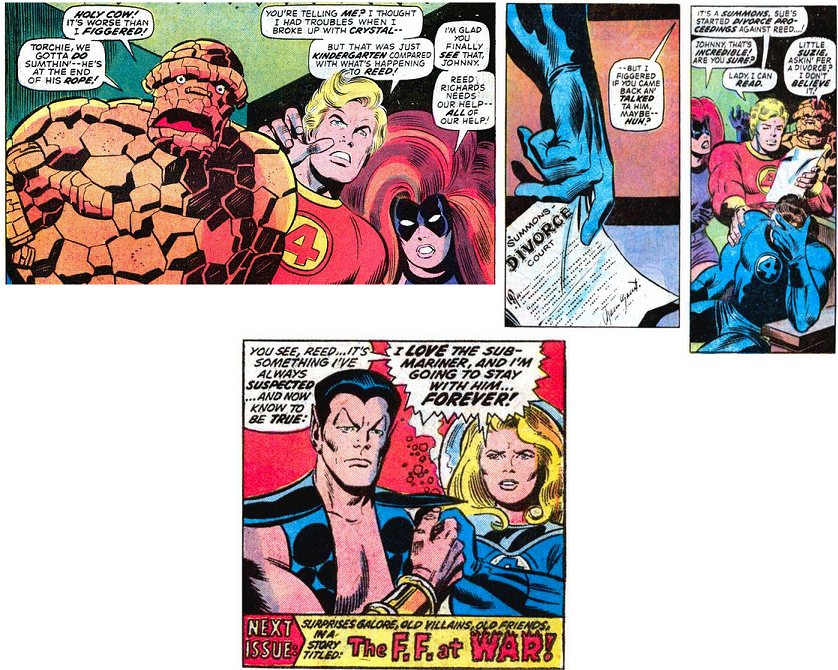
Divorce papers.
'Nuff said.
For why Sue went with Namor, see the notes to FF 243.
Other points to note
- Why does Sue move so quickly? She needs someone to help her
comatose son. She cannot afford to delay. Namor has access to
advanced technology. Maybe his technology won't help, but she
has to try: sitting in Pennsylvania won't save Franklin.
- This is one of many issues where Buckler uses poses from
earlier Kirby issues. See the notes to FF144 for why.
148
Issue 148: the psychological depth of the Great American Novel
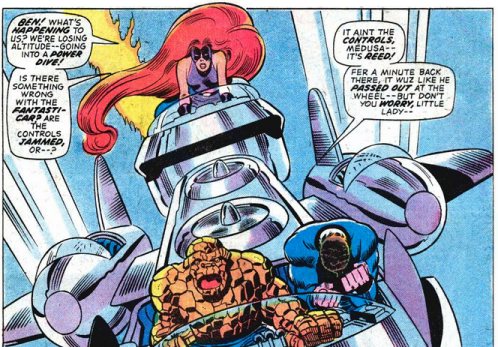
The Great American Novel
This is a powerful psychological issue. To see why, consider this criticism from a comic fan's point of view, on FF1by1.com:
"There
is an awful flaw right at the center of this issue — an annoyance that
builds to a frustration and then almost an insult as the story
progresses. And that is that the moment after the cliff-hanger of the
previous issue is never shown. The story picks up some hours after that
instant and we are promised that more will be revealed of that event but
all we are then shown is a one-page summary of the previous issue. Reed
has been told that she loves Namor and not him — what was his reaction?
Did he say anything to Sue? What was Ben and Johnny’s reaction?"
This is a classic example of why the Fantastic Four was The Great
American Novel and not just a comic: when forced to choose between being
a comic and a novel, the writers instinctively choose the novel. FF1by1
is correct in that, seen as a comic, obviously we should see a visible
result to the cliff hanger: they should have fought, or shouted, or
debated, or something! Any comic reader knows that! But this is not
primarily a comic. Stand back and we see something far more
powerful. The drama, the bottled up passion, the tragic power, is in Reed's bottled-up non-reaction.
Reed's reaction in context
Ever since 1961 we have seen Reed's difficulty with connecting
emotionally. Reed is the world's greatest hero,a man of pure heart
motivated by his concern for others, yet this very strength makes it
difficult for him to relate to others. Issue 1 set the template: Reed
turned his best friend into a monster and didn't realize that was a
bad thing. Throughout acts 1 and 2 he controlled and infantalized his
friends, and didn't realize he was doing it. There was very little
backlash at first, because Reed was so capable, and anybody near him
looked like an amateur. Bat as the stakes grew higher and the dangers
came faster and faster, he began to really need the others. And his
inability to connect with them became a bigger and bigger weakness. This
is the central theme of Reed's life: to learn that he cannot do it all
alone: he is not Mister Impossible.
Act 4 has been about the pressure and his inability to cope. For the
past several years we have seen him bottle up his problems. In FF142 for
example, after the greatest shock of all, he just stood there and did
not react for hours, and then turned his rage inward. So how does he
react now to the most devastating news of his life? He doesn't! He
can't! He turns it all on himself! All we see is the aftermath, where his inner tension is unbearable.
The power of the image
Look at Reed in that psychologically powerful splash page. Reed, once
the most verbose and flexible man, is now silent and rigid! This is
merely the most intense example of the problem he refuses to face until
issue 189 when he resigns: his loss of stretching power is paralleled by
him using fewer big words. He is no longer Mr Fantastic except in name,
a mockery of the reality. He is going through mental hell, and it's all
the more worse because emotion is the one thing he understands the
least.
Reed's frozen reaction to losing Sue is powerful, and familiar to
depressed, stressed and traumatised people everywhere. What can you say
when you have no words? But of course you cannot have a non-reaction as a
splash page, especially after using the same idea s the splash to
FF142, and at least there we had the drama of the others leaving. Here
the others, now with compassion for his suffering, don't know what to do
either, other than try to steer the ship in the direction Reed was when
he lost the power to act - another metaphor.
The contrast with Medusa
Note the dramatic contrast with Namor and especially Medusa. Reed does
not understand his wife. He does not understand his emotions. But Namor,
a man of passion, does. Medusa understands how to use passion to her
full advantage (as when she first appeared) and when to turn it off (as
when criticizing Crystal for being too open with her emotions). Medusa
is the genius of using passion, the greatest of all politicians (as
discussed elsewhere). So it is Medusa, with the aid of Namor, who
masterminds "Project Revival".
The power of Medusa, with her infinitely flexible hair, contrasts
with the powerlessness of Reed. Medusa is the de facto ruler of the
Inhumans because she speaks for Black Bolt: male and female in perfect
harmony, in contrast with Reed, ruler of the FF, who does not know how
to speak to his wife. (Even here there are layers of meaning: Black Bolt
cannot speak to Medusa either, so does she always say what he wants?
FF304 and annual 21 suggest not.)
Medusa, Thundra, and "war on the 36th floor"
Medusa is here to protect Reed, Just as in this issue Thundra protects
Ben. Both men are psychologically scared (Ben because he is not
psychologically ready to lead); both need the women to take charge.
This issue is at first glance about a random battle with the
Frightful Four, but look closer: the title is "war on the 36th floor".
This issue makes clear that the floor in question is the first one
occupied by the Fantastic Four. It is where the regular world ends and
the home of the Fantastic Four begins. Like all the floors it contains
some laboratories, but all diagrams since FF annual 1 have made clear
that the first floor above the regular building is the FF's living
quarters. So "war on the 36th floor". The battle with the Frightful Four
is important because it symbolises the frightful battle inside the
family home,
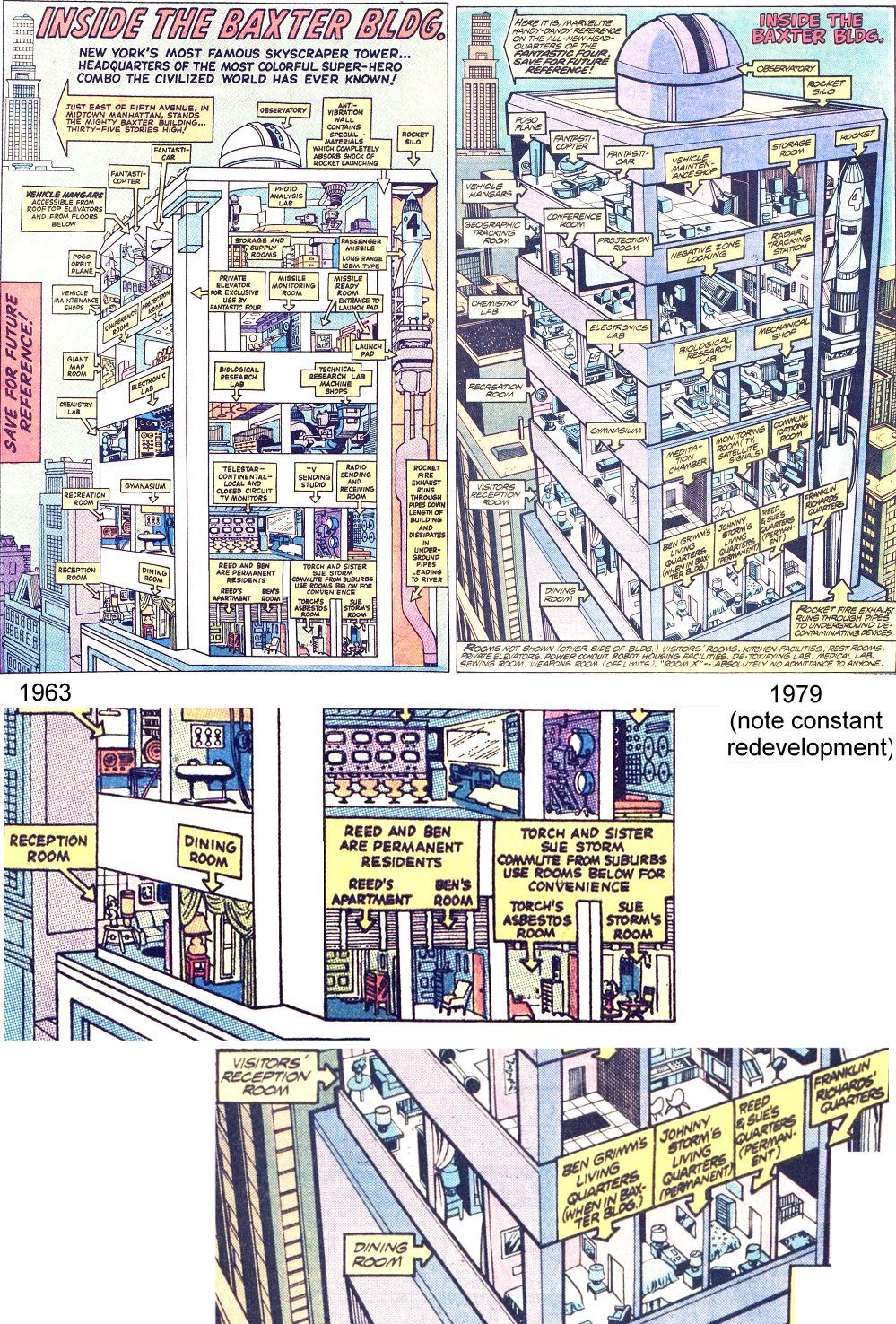
36th floor? I thought the Baxter building only had 35?
The Baxter Building is routinely referred to as having 35 floors. This
is why you should never rely on the official handbook. The task of
analyzing every issue takes years (as I know from experience!), so the
publishers of the handbook take many short cuts. Often they simply make
stuff up, such as the often quoted "fact" that Ben Grimm can lift 85
tons: a figure that was never strictly true. If somebody vaguely
remembers an issue saying "35 floors" they just put it in the handbook.
It is then quoted extensively and is assumed to be gospel. But look
closer: there are 35 normal rented floors, plus a penthouse of 5 floors
occupied by the Fantastic Four, making 40 floors total.
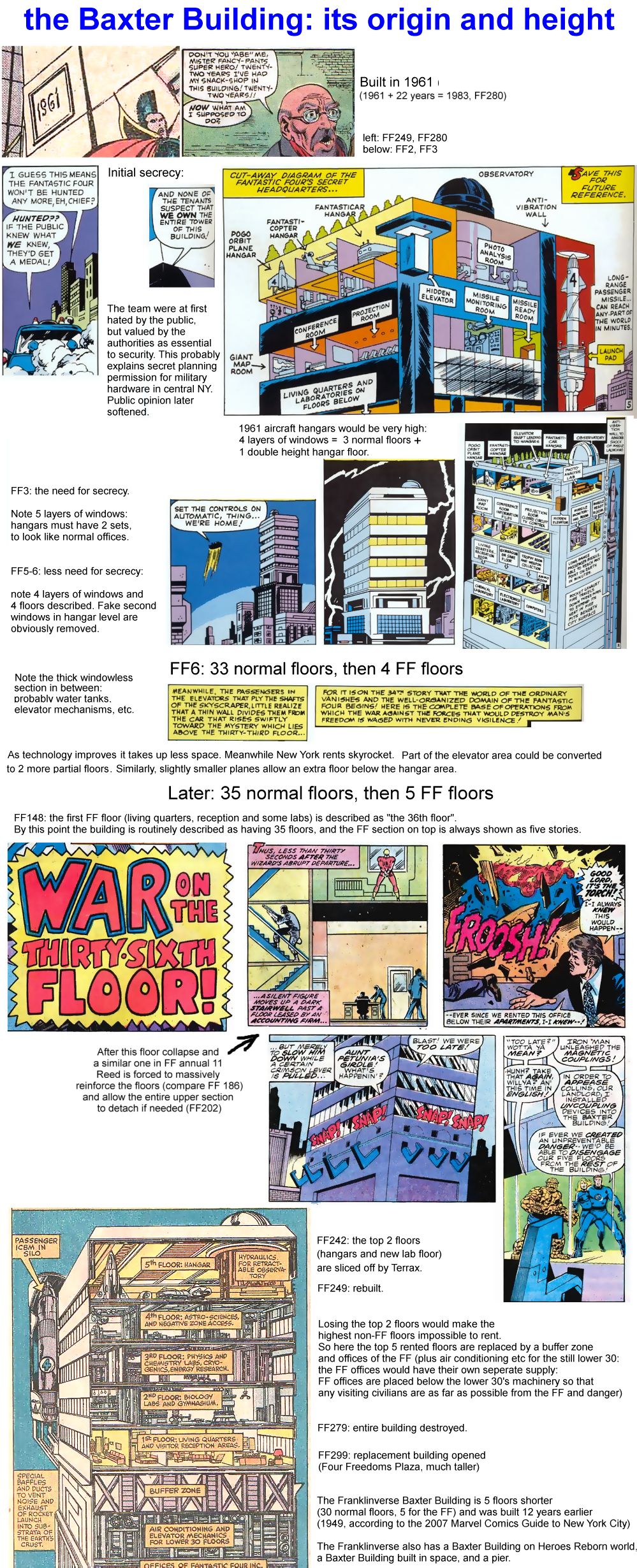
The height is confirmed in issue 168. Note that the Franklinverse building is very different.
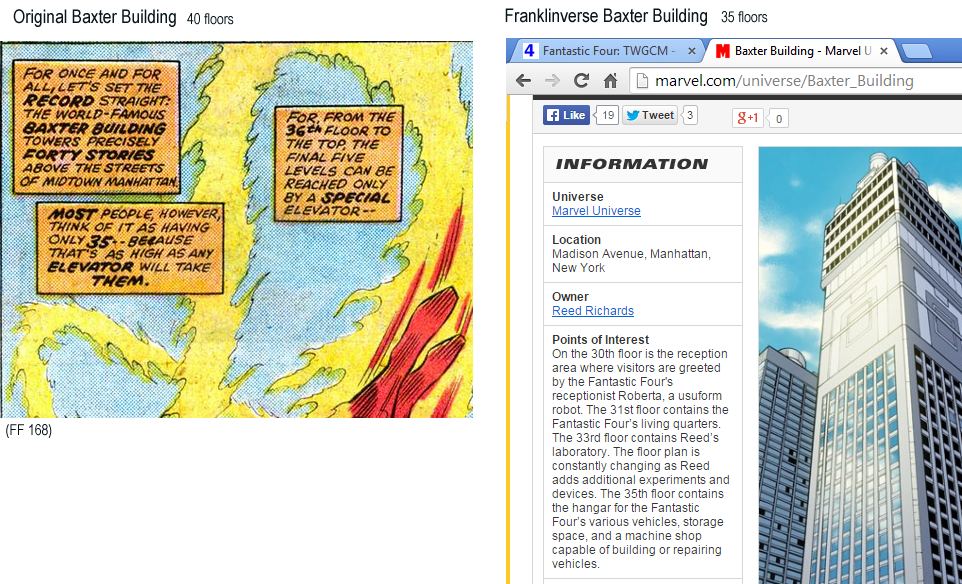
The origin of the "35 stories total" myth
In FF 249, when Gladiator lifts the building, Reed looks out of the
window and says that should not be possible. The caption says "thirty
five stories down to the street... thirty five stories to the
incredible!" This is a few pages after the diagram that showed five
stories for the FF and refers to "the lower 30 stories". I think this is
where people get the "35 stories" idea. If that was the only reference
then I would agree that 35 stories total is the most likely conclusion.
However, that contradicts previous issues, including the very first
detailed description in FF 6. it also contradicts the comic itself: Reed
is on the 4th floor and looking down, so if he looked down past 35
stories the building would have at least 37 stories: i.e. Reed was
looking down past 35 stories, plus his own plus the one above.
So what does looking down past 35 stories mean? Let's look closer. The
context is that Reed thinks the building should crumble under its own
weight. I doubt that is true of the FF part of the building: it's so
heavily reinforced that it could probably be tossed around like a ball
and survive. The FF's section is detachable (see FF202), and sits on top
of the regular building, so Reed probably thinks of it as a separate
unit. So when Reed talks of the 35 stories below him, and how it should
crumble, he probably means the 35 regular stories below the FF's
headquarters.
Other points to note
- Psychosomatic illness
Reed's mental state is affecting his body: that is, his pain is
psychosomatic. In this issue he faints. Later he holds his right
arm in pain: within ten issues it will be clear that he's losing
his ability to stretch. Physically it began in FF140 when
Annihilus zapped him, just as he would zap Franklin. But mentally the
seeds of Reed's weakness were there from issue 1.
-
Sexism
This is not the first time that Reed has fainted due to stress. He
fainted before in FF124, and faints again in FF 184. (This is in
addition to any attacks of knock-out gas or when the whole team
passes out for some reason.)
Carol Strickland, in her letter published in FF216 (see Sue's page for details) accused
of Sue of fainting, and demanded that she be removed from the team.
The psychology of this is interesting: people are so conditioned to
believe that somebody is weak that they will see things that are not
there. It is even more interesting that it's a woman who demands the
woman be removed. Strickland's demands, to make Sue more violent,
were adopted by Byrne.
Critics sometimes accuse Sue of fainting. Yet it is actually Reed
who faints the most. Sexism is an important theme to discuss and
here we see it first hand. It is interesting that a woman,
Strickland, will believe that women are portrayed as fainters, and
should be removed from the team.
- Peter's humiliation
The saga of Petruski's decline continues. In his previous
appearance he showed his tendency to panic and apologize. Here he fails
the Wizard by leading the Torch to him, and the Trapster ends up
suspended in a trap. He has lost all credibility. See his own page for more about the character.

149
Issue 149: Sue gives Reed a second chance

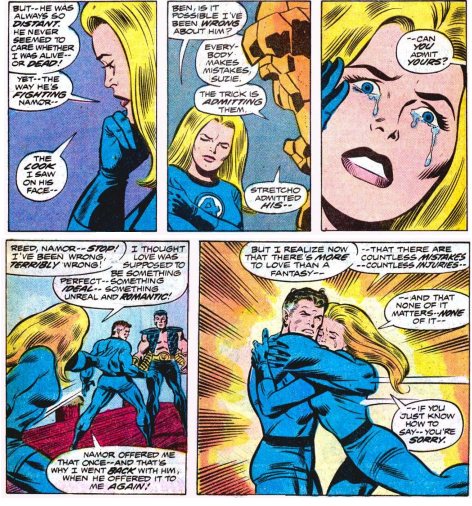
So Sue gives Reed another chance. Note that Ben says that Reed
admitted his mistake. But he never did: except to admit that he
failed. Failing and making a mistake are two different things. Reed
has collapsed due to stress he had admitted that his actions had bad
consequences, he's been cold, he's been angry, and mostly he has
wished he could have done better. But he has never admitted to
making the wrong choice. He hasn't learned his lesson.
FF133-149 in hindsight
These issues change Reed permanently. After this near-divorce Reed will never again be his confident self. Like any
severe depressive he will learn to hide it: he will never again
let his feelings show. But for now his agony is all on the
surface.



















 FF133
134
135
136
137
138
139
140
141
142
143
144
145
146
147
148
149
FF133
134
135
136
137
138
139
140
141
142
143
144
145
146
147
148
149














































